Vermont Black History Database
The Vermont Black History Database is a project of the Vermont Historical Society to make the study of Black History in our state more accessible. The database highlights black people and places that made an impact on the history, culture, and landscape of our state. The database is meant to be a starting place, a guide to further study and exploration. This is an ongoing project and we welcome submissions for inclusion in the database. Please email recommendations for inclusion to steve.perkins@vermonthistory.org
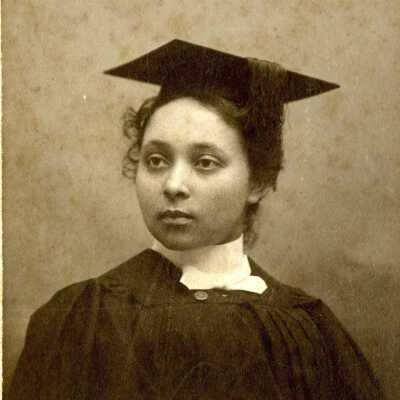

Anderson, Mary Annette (1874-1922)
Name/Title
Anderson, Mary Annette (1874-1922)
Description
Born:July 27, 1874 in Shoreham, Vermont
Died:May 2, 1922 in Shoreham, Vermont
First African-American woman to be inducted into Phi Beta Kappa and valedictorian of Middlebury College, 1899.
Died:May 2, 1922 in Shoreham, Vermont
First African-American woman to be inducted into Phi Beta Kappa and valedictorian of Middlebury College, 1899.
Biographical Information
Education
Northfield Seminary
Middlebury College (1899)
Biography
Mary Annette Anderson was born in Shoreham, Vermont, to William and Philomine Anderson. William, a farmer, was formerly enslaved in Virginia and Philomine was of French and Native American descent. Mary graduated Northfield Seminary for Young Ladies in Massachusetts and entered Middlebury College in 1895. She was valedictorian of the Middlebury class of 1899 and became the first African-American woman to be inducted into the national honors society, Phi Beta Kappa.
After college, Anderson moved to New Orleans, Louisiana, where she taught at Straight College for one year. She then went to Washington, D.C. as professor of English grammar and history at Howard University. Upon her marriage to Walter Louis Smith in 1907, Anderson stopped teaching, as was custom in society at that time. The couple eventually bought a home in Shoreham, Vermont, where Anderson died in 1922.
Occupation
Professor, Straight College
Professor, Howard University
Entry/Object ID
1.1.6
Web Links and URLs

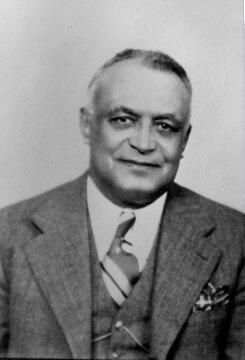
Anderson, William John, Jr. (1876-1959)
Name/Title
Anderson, William John, Jr. (1876-1959)
Description
Born: February 14, 1876 in Shoreham, Vermont
Died: August 28, 1959 in Burlington, Vermont
Primary Residence: Shoreham
Prominent black orchardist who was the second African American to serve in the Vermont legislature.
Died: August 28, 1959 in Burlington, Vermont
Primary Residence: Shoreham
Prominent black orchardist who was the second African American to serve in the Vermont legislature.
Biographical Information
Education
Mount Herman Preparatory School
Biography
Born in 1876 to former enslaved farmer William Anderson and his French-Canadian wife Philomen Langlois in Shoreham, Vermont, William Anderson, Jr. attended Mount Herman Preparatory School in Massachusetts. He stayed on at the school to manage their laundry service for a number of years. While there he became active in the Republican Party, attending Gov. Coolidge's inaugural ceremonies in 1919.
In 1920 he returned to Shoreham where he began his orchard business. In 1935 he was elected the president of the Vermont Horticultural Society. Through his actions, he integrated the Vermont Masons through a unanimous vote by all lodges. He served in a number of elected town offices before his election to the legislature in 1945.
With his election, he became the second African American to serve in the Vermont legislature - more than 100 years after Alexander Twilight in 1836. At the time, many Montpelier institutions such as the Pavilion Hotel and the Montpelier Tavern (now Capitol Plaza) were closed to him due to segregation. At the national level, he worked with U.S. Senator from Vermont Warren Austin to increase the number of black officers in the Army and create a Senior ROTC unit at Tuskegee University.
Occupation
Orchardist
Politician
Entry/Object ID
1.2.9
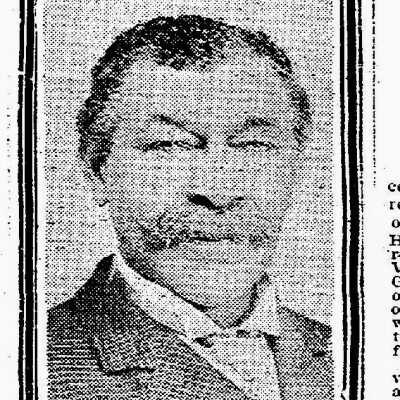
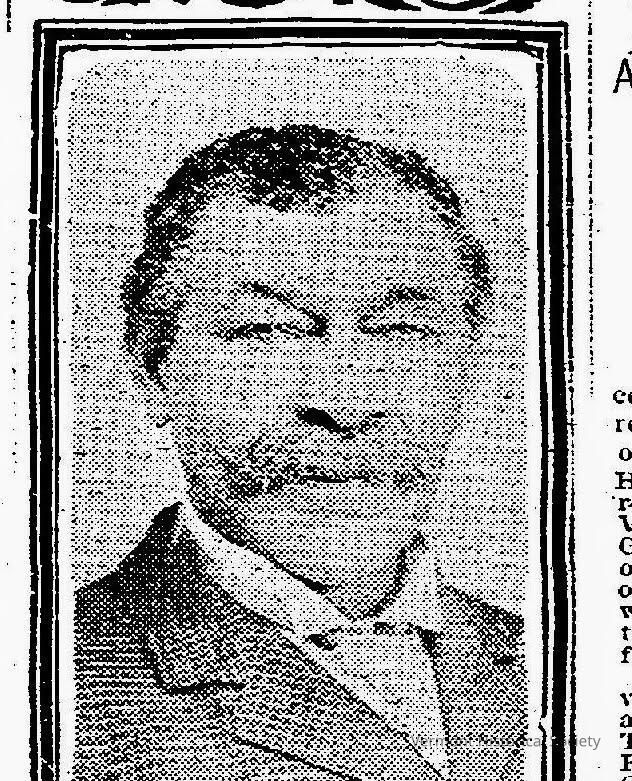
Bates, Stephen (1842-1907)
Name/Title
Bates, Stephen (1842-1907)
Description
Born: 1842 in Shirley, Virginia
Died: 1907 in Vergennes, Vermont
Primary Residence: Vergennes
Stephen Bates is Vermont’s earliest known Black Sheriff and Chief of Police. Mr. Bates was first elected to the office of Sheriff in Vergennes, Vermont, in 1879, fourteen years after the end of the Civil War. City records spanning 29 years, between 1879 and 1907, show that Mr. Bates was elected to the office of Sheriff in all but six of those 29 years. In addition to those elections, Mr. Bates was also often appointed Chief of Police during this period. Altogether, Mr. Bates served the city of Vergennes almost consecutively for 25 years.
Died: 1907 in Vergennes, Vermont
Primary Residence: Vergennes
Stephen Bates is Vermont’s earliest known Black Sheriff and Chief of Police. Mr. Bates was first elected to the office of Sheriff in Vergennes, Vermont, in 1879, fourteen years after the end of the Civil War. City records spanning 29 years, between 1879 and 1907, show that Mr. Bates was elected to the office of Sheriff in all but six of those 29 years. In addition to those elections, Mr. Bates was also often appointed Chief of Police during this period. Altogether, Mr. Bates served the city of Vergennes almost consecutively for 25 years.
Biographical Information
Biography
According to obituaries and historical records, Mr. Bates was born in Shirley, Charles City County, Virginia in 1842, although his grave marker in Prospect Cemetery in Vergennes claims his birth year as 1843. His obituary says that he was born of “free parents,” but historical records from the Shirley Plantation indicate that he and family members, parents and siblings, were enslaved there. His obituary states that he lived with the Hill Carter family, who were (and still are) owners of the Shirley Plantation, and that Mr. Bates was trained as a waiter and his father as a carpenter. Mr. Bates ran away from the Shirley Plantation in August of 1862 when McClellan’s army retreated from the Berkley Plantation at Harrison’s Landing, which was nearby. His obituary states that he was in the service of officers at Harrison’s Landing and afterwards went to Washington.
In Washington, sometime during or just after the Civil War, Mr. Bates became employed by Frederick E. Woodbridge, a U.S. Congressman from Vermont, whose family residence was in Vergennes, Vermont. Newspaper articles from the time indicate that Mr. Bates was employed as Woodbridge’s coachman. Woodbridge served in the United States House of Representatives from 1863 to 1869 and afterwards returned to his home in Vergennes where he lived until his death in 1888. Mr. Bates returned to Vergennes with Woodbridge and remained loyal to him throughout the remainder of his life. The census of 1870 indicates that Mr. Bates boarded in a home next door to the Woodbridge family home, currently the Rectory of St. Paul’s Episcopal Church, of which Mr. Bates was a long-time member. His occupation is listed as coachman. He was married to Frances Mason of Elizabethtown, NY in 1871 and had two children, Rose and Fredrick Bates. The family lived in their home on North Street in Vergennes, which was greatly damaged by fire in 1880, possibly due to arson.
Much has been written about Sheriff Bates in newspaper accounts of the time regarding his work as Sheriff and Chief of Police. His obituary stated that “While Chief of Police he had the satisfaction of arresting ‘Brooklyn Slim’ and ‘Ottawa Red,’ two members of a gang of post office burglars, who are now serving sentences in the state prison, and at one time had in his custody as a tramp, Perry the New York train robber, but released him before he was informed that the Pinkertons wanted him.” Other newspaper articles describe him as the arresting officer in cases involving murder, grand larceny, check forgery, vagrancy, and other offenses in Vergennes and the surrounding areas, including Panton and Ferrisburg. A respected city official, his commanding figure and distinctive hat were a familiar and welcome sight in the community.
Sheriff Bates’ obituary stated that he “was almost entirely a self-taught man, and in the discharge of the duties of his office was cool and self restrained, rarely if ever acting hastily. He died from cardiac arrest while milking a cow on June 10th, 1907, the last year he was elected Sheriff. His obituary states that his funeral at St. Paul’s was well attended. In 1939, many years after his death, a reporter from the Enterprise and Vermonter wrote an article on the occasion of Vergennes’ 150th anniversary. Many notable citizens were remembered, including Frederick Woodbridge and Sheriff Bates. The reporter said of Sheriff Bates that “…he gave the best of satisfaction to all concerned.” Even then the reporter posed a question: Had there ever been another Black Sheriff in Vermont? One hundred and forty-one years would pass before another Black officer would be elected as Chief of Police in Montpelier in 2020.
Occupation
Coachman
Sheriff
Police Officer
Entry/Object ID
1.2.29
Web Links and URLs
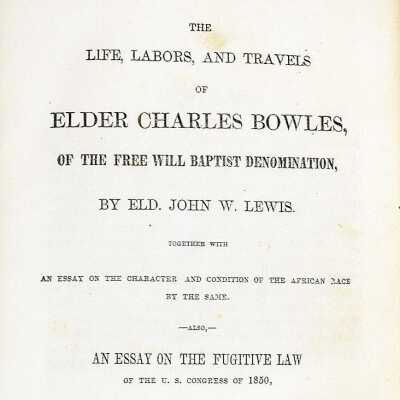

Bowles, Rev. Charles (1761-1843)
Name/Title
Bowles, Rev. Charles (1761-1843)
Description
Born: 1761 in Boston, Massachusetts
Died: March 16, 1843 in Malone, New York
Revolutionary War veteran and Free Will Baptist minister in Huntington, Vermont.
Died: March 16, 1843 in Malone, New York
Revolutionary War veteran and Free Will Baptist minister in Huntington, Vermont.
Biographical Information
Biography
Born free in Boston to a black father and bi-racial mother and raised by a foster family, Charles Bowles made a name for himself in the infantry during the American Revolution and later as a sailor and cook aboard a number of New England ships.
In 1808 he bought a farm in Huntington, Vermont where he embarked on a new life as a preacher, eventually ordained as a minister in the Free Will Baptist Church. He organized a number of churches including those in Huntington, Starksboro, Hinesburg, and Enosburgh. He organized the yearly Free Will Baptist meetings for the entire Champlain Valley.
As a prominent preacher in the Second Great Awakening, he led revivals and camp meetings that welcomed all races and genders and, by many accounts, were boisterous and noisy affairs. The area of Huntington and Hinesburgh around his home became a center of black lives in Vermont with a number of black veterans settling in the area and remaining for generations.
Later in life his calling took him to northern New York where he organized more churches before his death in 1843 in Malone.
Occupation
Farmer
Preacher
Entry/Object ID
1.2.3
Web Links and URLs
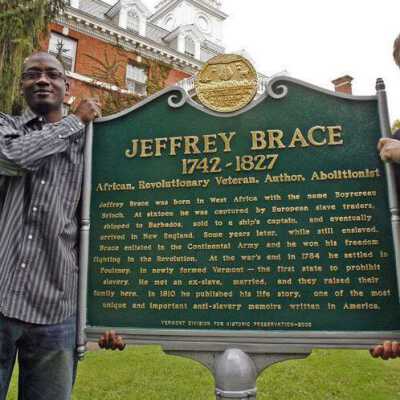
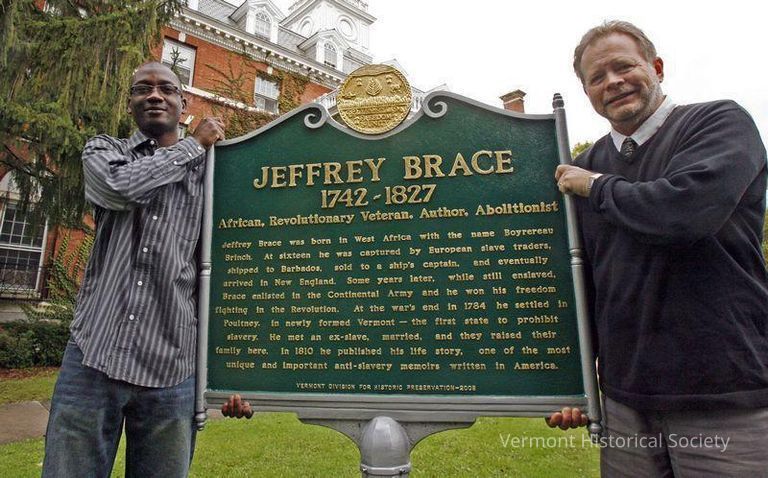
Brace, Jeffrey (1742-1827)
Name/Title
Brace, Jeffrey (1742-1827)
Also Known As
Boyrereau Brinch
Description
Born: circa 1742 in West Africa
Died: April 20, 1827 in Georgia, Vermont
Primary Residence: Poultney and Georgia
Born Boyrereau Brinch in West Africa and captured and enslaved as a teen, the later-self-identified Jeffrey Brace was enslaved in Barbados and Connecticut before serving as a soldier in the American Revolution where he gained his freedom. He lived the rest of his life in Vermont where he dictated his autobiography in 1810.
Died: April 20, 1827 in Georgia, Vermont
Primary Residence: Poultney and Georgia
Born Boyrereau Brinch in West Africa and captured and enslaved as a teen, the later-self-identified Jeffrey Brace was enslaved in Barbados and Connecticut before serving as a soldier in the American Revolution where he gained his freedom. He lived the rest of his life in Vermont where he dictated his autobiography in 1810.
Biographical Information
Biography
Born into an aristocratic family in West Africa in 1742, Boyrereau Brinch, was captured by European slave traders as a teen in 1758. He survived the middle passage, ending up in the British colony of Barbados where he endured "slave-breaking" and was eventually sold to Captain Isaac Mills. Mills trained Brinch as a sailor and he fought in the Seven Years War (French and Indian War) participating in the capture of Havana and travelling to Dublin, Savannah, New York, Newport, Halifax, and Boston. During his time on the ship he acquired the name Jeffrey Brace, which he used for the rest of his life.
In the late fall of 1763 Mills sold him to a business associate in Connecticut. Brace was enslaved by a series of cruel Connecticut masters until his purchase by the Widow Mary Stiles in 1768. Stiles taught him to read and upon her death he passed to her son in 1773.
Around 1777 Brace enlists in the American Revolutionary Army. He fought throughout the northeast and in 1783 he is honorably discharged with a badge of merit and manumitted (freed).
In 1784 Brace heads to Vermont where he purchases uncleared land in Poultney. He marries the African-born widow Susannah Dublin and works to establish a farm on his land. Brace is listed in the 1790-91 U.S. Census as head of household with three children. In 1802 the Braces move to Sheldon in northern Vermont where they acquire land, but by 1805 had settled permanently in Georgia where he joined the Baptist Church.
By 1810 Brace, now a widow, was blind and living in Georgia where he was approached by lawyer Benjamin Prentiss to record his life story. Brace recalled, in vivid detail, his autobiography which was published by Prentiss in October of that year. The autobiography is one of the few direct recordings of an African who recalls life in Africa, describes the middle passage, slavery, fighting in two wars, and freedom.
Jeffrey Brace died at home in 1827. His descendants generally stayed in Franklin County with two great grandchildren serving for the Union Army during the Civil War.
Occupation
Sailor
Soldier
Farmer
Entry/Object ID
1.2.1
Web Links and URLs
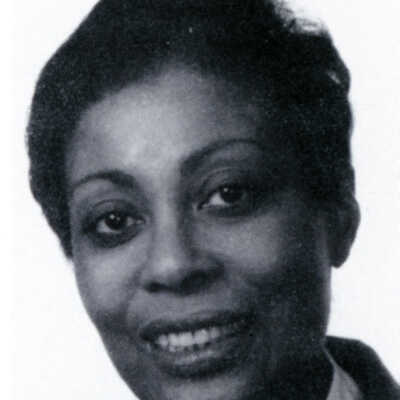
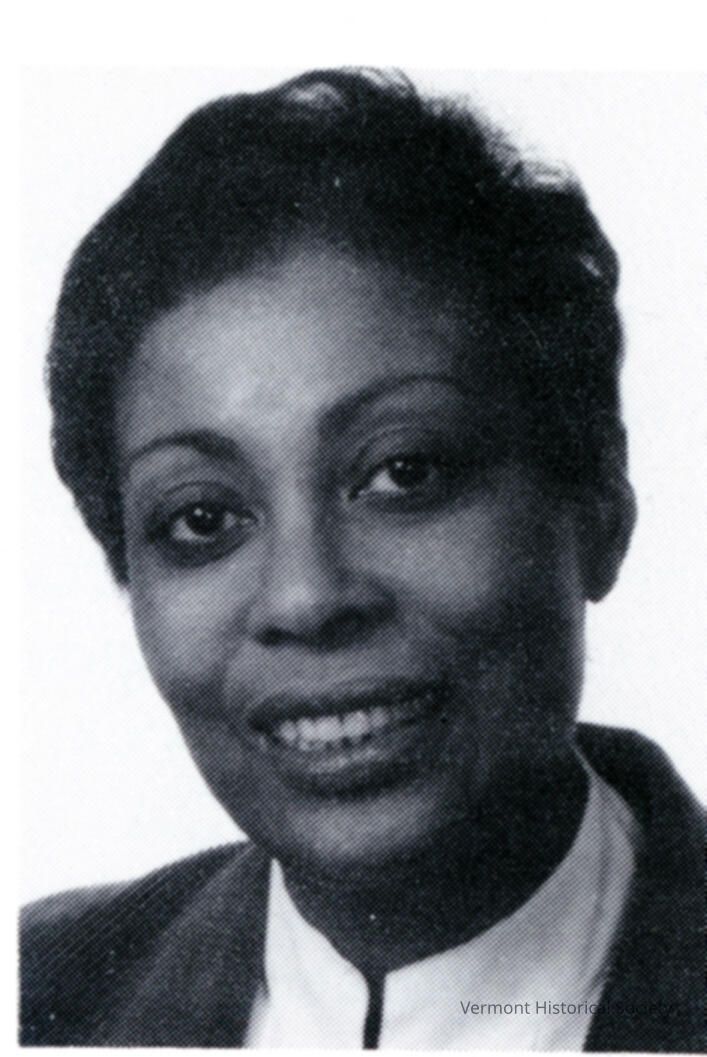
Bright, Louvenia Dorsey (b. 1941)
Name/Title
Bright, Louvenia Dorsey (b. 1941)
Description
Born: November 21, 1941 in Chicago, Illinois
Died: July 29, 2023 in Forest Park, Illinois
Primary Residence: South Burlington
Louvenia Dorsey Bright was the first African-American woman elected to the Vermont legislature (1989-1994).
Died: July 29, 2023 in Forest Park, Illinois
Primary Residence: South Burlington
Louvenia Dorsey Bright was the first African-American woman elected to the Vermont legislature (1989-1994).
Relationships
Related Places
Place
South Burlington
City
Chittenden County
County
Vermont
State/Province
United States of America
Country
North America
Biographical Information
Education
B.S. and M.Ed., Wayne State University (1964, 1971)
CAS, UVM (1987)
Biography
Louvenia Dorsey Bright was born in Chicago and educated in Michigan. A life-long educator, she took a teaching position in Colchester when her husband was hired as a professor of education at UVM. She eventually joined the UVM faculty as an associate professor of education.
Bright ran for, and won, the district 6-3 seat representing South Burlington in the Vermont legislature. She became the first black woman to hold a seat in the Vermont legislature. And, along with Francis Brooks, was one of only two African-Americans in the legislature at the time. She served until 1994 when her family moved to Illinois.
Occupation
Educator
Politician
Entry/Object ID
1.2.12

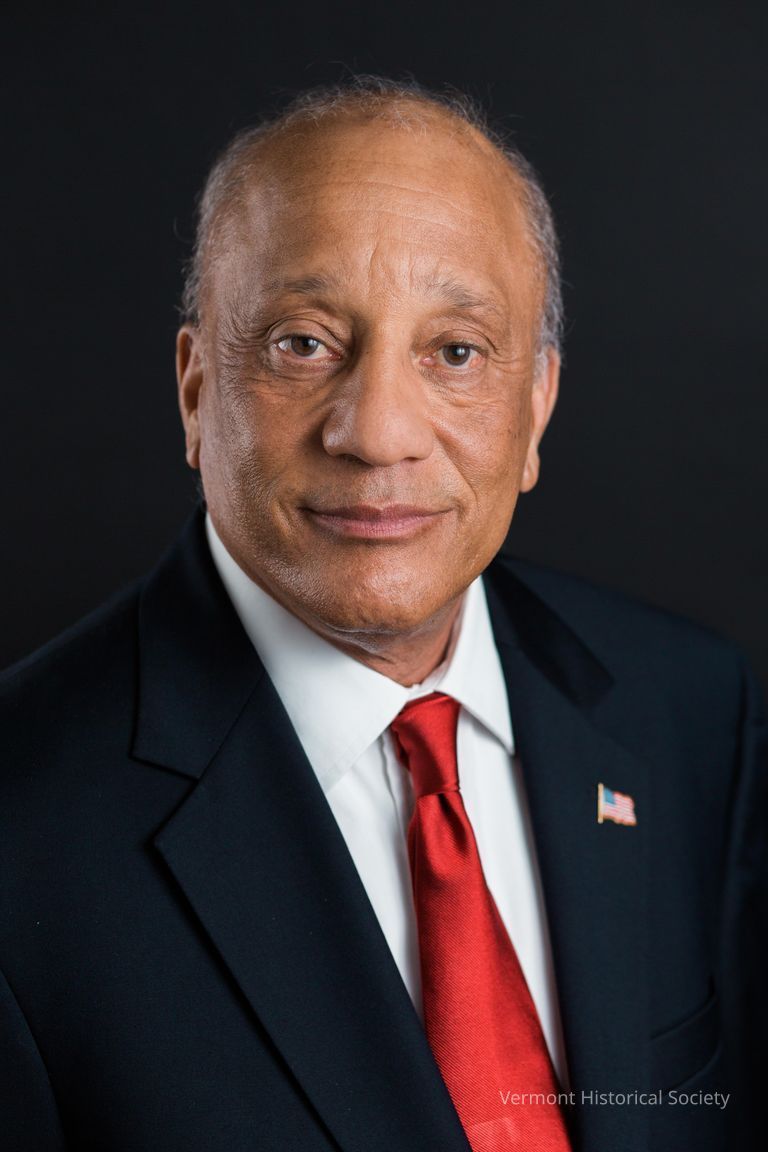
Brock, Randolph "Randy" D., III (b. 1943)
Name/Title
Brock, Randolph "Randy" D., III (b. 1943)
Description
Born: September 28, 1948 in Philadelphia, Pennsylvania
Primary Residence: Swanton, Vermont
Randy Brock served as Vermont Auditor or Accounts and as a Vermont Senator. He was the republican nominee for Governor in 2012 and the nominee for Lt. Governor in 2016.
Primary Residence: Swanton, Vermont
Randy Brock served as Vermont Auditor or Accounts and as a Vermont Senator. He was the republican nominee for Governor in 2012 and the nominee for Lt. Governor in 2016.
Biographical Information
Education
BA, Middlebury College
MA, Yale University
Biography
Randolph "Randy" Brock was born in Philadelphia, Pennsylvania and made his way to Vermont to study at Middlebury College. He went on to receive a graduate degree from Yale University. He served in the U.S. Army, attaining the rank of captain and earned the Bronze Star and Army Commendation Medal for his service in Vietnam.
He spent much of his career at Fidelity Investments where he retired as an executive vice president.
Randy was elected State Auditor in 2004 and served for two years before losing a very close election in 2006. He was elected to the State Senate in 2008 and served in that body until running unsuccessfully for governor in 2012 as the Republican nominee. He was the first African-American to run for Governor of Vermont. He received the Republican nomination for Lt. Governor in 2016, ultimately losing the general election. He returned to the State Senate in 2017 upon the resignation of a fellow lawmaker. He continues to serve in that seat at present.
Occupation
Accountant
Politician
Entry/Object ID
1.2.15
Web Links and URLs

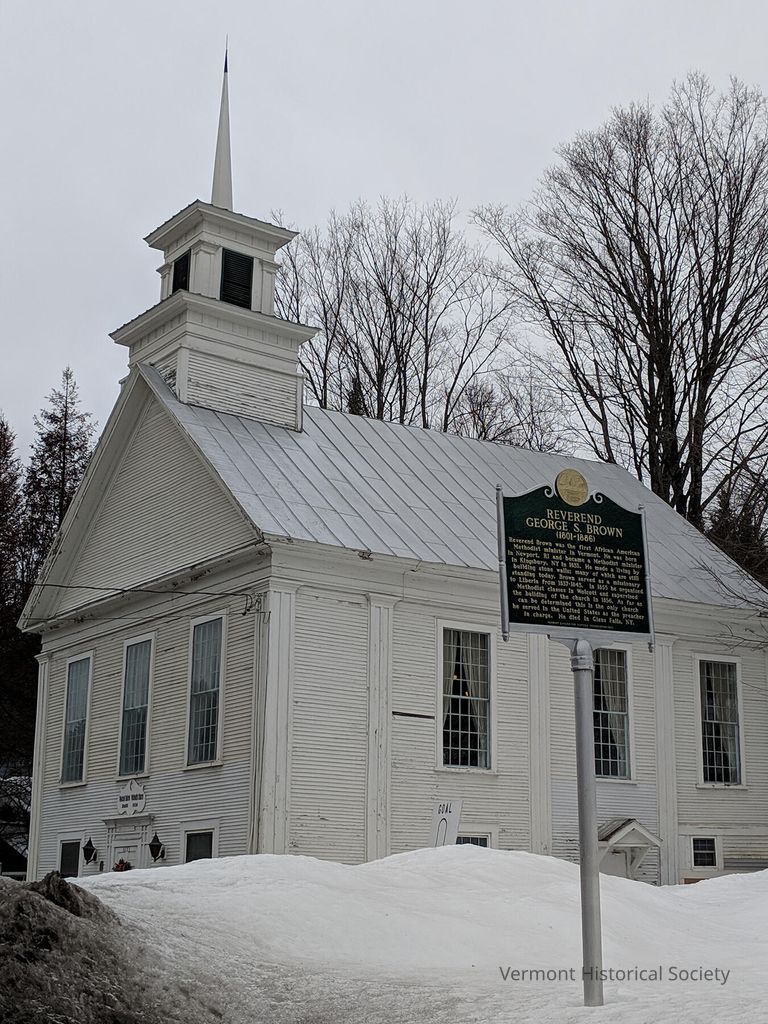
Brown, Rev. George S. (1801-1886)
Name/Title
Brown, Rev. George S. (1801-1886)
Description
Born: July 25, 1801 in Newport, Rhode Island
Died: April 10, 1886 in Glens Falls, New York
Rev. George S. Brown was an early black Methodist minister who served as a circuit preacher, missionary in Liberia, and the pastor of the Wolcott Methodist Church.
Died: April 10, 1886 in Glens Falls, New York
Rev. George S. Brown was an early black Methodist minister who served as a circuit preacher, missionary in Liberia, and the pastor of the Wolcott Methodist Church.
Biographical Information
Education
Cazenovia Seminary
Biography
George S. Brown was born to a free black family in Newport, Rhode Island in 1801. The family soon moved to Connecticut where George was raised in Calvinist-leaning household. At age 14 he heard the travelling preacher Lorenzo Dow at a camp meeting in Mansfield, Connecticut and made a decision to pursue the professional of preacher.
By 1827 he had settled in Kingsbury, New York where he joined the Baptist church but after meeting with Methodist Episcopal circuit rider William Ryder he converted to the Methodist sect and in 1833 received a license to preach. During this time he learned the trade of the stone mason and became quite well know for his skills in building walls. He expressed an interest in becoming a missionary in Liberia, an African country created by anti-slavery advocates in the U.S. who felt African-Americans should be sent back to Africa.
He traveled to Vermont where he was to study with Rev. Tupper of Monkton. While in Vermont he started preaching in Ferrisburgh where he attracted more attention than the local circuit rider and was ultimately sent back to New York as a trouble-maker. He attended Cazenovia Seminary before being assigned as a missionary to Liberia.
From 1836 to 1844 he served on-and-off as a missionary in Liberia. Apparently he was an effective preacher but very bad politician. He found himself in the middle of a feud between two white missionary leaders that ended in his censure and ultimate ejection from the church. During this time he married twice and had a daughter who died young. In 1844 he sailed for home, determined to clear his name and rejoin the church. Lacking sufficient funds, his wife remained in Africa.
Back in the U.S. he faced a racist wall of silence from the Methodist church. Though he did find friends to advocate for him in upstate New York, the elders refused to hear his petition. He ultimately engaged a lawyer and sued one of the Methodist leaders for libel. With legal victory almost assured the defendant chose to settle the case. Brown rejoined the church but was deemed a trouble-maker and pariah. It was at this time he ended up in northern Vermont.
From 1854 to 1858 he served the Methodist meeting of Wolcott. During that time the congregation grew such that they designed and built a church. Rev. Brown oversaw the planning and building of the church, probably laying the stone foundation himself. At this same time his wife passed away in Liberia - he, sadly, was never able to reunite with her after leaving in 1844.
In 1858 he was hired away to build the walls of an estate in Michigan. Upon completion he moved back to the Glens Falls area of New York where he continued to preach until his death in 1886. A state historic site marker stands in front of his Wolcott church, memorializing this remarkable man.
Occupation
Stone Mason
Methodist Preacher
Entry/Object ID
1.2.18
Web Links and URLs

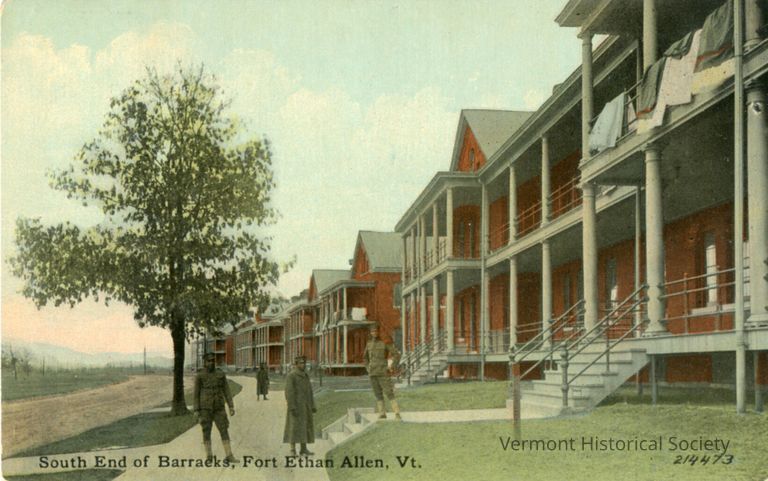
Buffalo Soldiers (U.S. 10th Cavalry)
Name/Title
Buffalo Soldiers (U.S. 10th Cavalry)
Description
In July of 1909 the famed, “Fighting” 10th Cavalry Regiment of the United States Army made its way to a new posting at Fort Ethan Allen in Colchester, just outside Burlington. One of four segregated black army regiments collectively called the Buffalo Soldiers, the 10th made a name for itself on the western plains, in the Philippines, and for charging up San Juan Hill in Cuba alongside Teddy Roosevelt and his Rough Riders. However, it was not its fighting prowess that so impacted Vermont, but the almost instantaneous diversification of Vermont’s largest city.
At the beginning of the 20th century, the greater Burlington area had a little over 100 black residents. When the cavalry came, along with their families and other camp followers, the black population rose to over 1,500.
Contemplating this change in demographics, citizen groups and leading newspapers, including the Burlington Free Press and Rutland Herald, proposed Jim Crow laws such as segregated trolleys and other public services. The national press quickly jumped on these racist statements in a state that prided itself on its longstanding anti-slavery and equality stances. Business leaders and state politicians, embarrassed by the characterization, quickly put an end to the discussion of segregation laws and awaited the arrival of the troopers.
White Vermonters were quickly won over by the professionalism and openess of the 10th Regiment. Troopers participated in parades and civic events, invited the public to cavalry exercises, performed band concerts, and participated in baseball and basketball contests. Though many private businesses maintained discriminatory practices common to the time, the four years the cavalry stayed in Burlington media reported no overt racial tensions or violence. A small, black business community grew up to provide goods and services to the troops.
Though it advocated for segregation laws in 1909, the Burlington Free Press, in 1913, praised the troops and extolled the “good-will” that now existed between “the regiment and the people of this state.” The white community extended this praise only after the black troops had proved themselves to be good neighbors. No white regiments were ever required to live up to such standards. The Buffalo Soldiers left Vermont in December of 1913, and were replaced, with little fanfare, by the 2nd Regiment, an all-white unit.
At the beginning of the 20th century, the greater Burlington area had a little over 100 black residents. When the cavalry came, along with their families and other camp followers, the black population rose to over 1,500.
Contemplating this change in demographics, citizen groups and leading newspapers, including the Burlington Free Press and Rutland Herald, proposed Jim Crow laws such as segregated trolleys and other public services. The national press quickly jumped on these racist statements in a state that prided itself on its longstanding anti-slavery and equality stances. Business leaders and state politicians, embarrassed by the characterization, quickly put an end to the discussion of segregation laws and awaited the arrival of the troopers.
White Vermonters were quickly won over by the professionalism and openess of the 10th Regiment. Troopers participated in parades and civic events, invited the public to cavalry exercises, performed band concerts, and participated in baseball and basketball contests. Though many private businesses maintained discriminatory practices common to the time, the four years the cavalry stayed in Burlington media reported no overt racial tensions or violence. A small, black business community grew up to provide goods and services to the troops.
Though it advocated for segregation laws in 1909, the Burlington Free Press, in 1913, praised the troops and extolled the “good-will” that now existed between “the regiment and the people of this state.” The white community extended this praise only after the black troops had proved themselves to be good neighbors. No white regiments were ever required to live up to such standards. The Buffalo Soldiers left Vermont in December of 1913, and were replaced, with little fanfare, by the 2nd Regiment, an all-white unit.
Entry/Object ID
1.2.10
Web Links and URLs

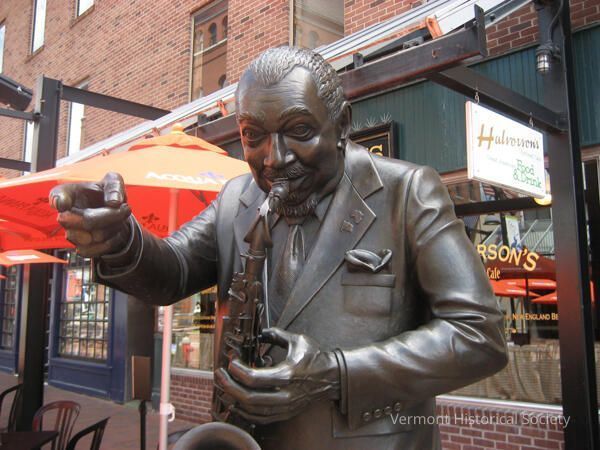
Burrell, Joseph Henry "Big Joe" (1924-2005)
Name/Title
Burrell, Joseph Henry "Big Joe" (1924-2005)
Description
Born: February 9, 1924 in Port Huron, Michigan
Died: February 2, 2005 in Burlington, Vermont
Primary Residence: Burlington
"Big Joe" Burrell was an iconic fixture in the Burlington music scene from the late 1970s to his death in 2005. He inspired an entire generation of Vermont musicians, received two keys to the city of Burlington, and is memorialized by a life-sized statue on the Church Street Marketplace.
Died: February 2, 2005 in Burlington, Vermont
Primary Residence: Burlington
"Big Joe" Burrell was an iconic fixture in the Burlington music scene from the late 1970s to his death in 2005. He inspired an entire generation of Vermont musicians, received two keys to the city of Burlington, and is memorialized by a life-sized statue on the Church Street Marketplace.
Biographical Information
Biography
One of seven children, "Big Joe" Burrell spent his early years in his hometown of Port Huron, Michigan, surrounded by his musical family. At age 10, his mother borrowed $5 to buy him a saxophone which he taught himself to play. When he reached his teens he dropped out of high school to focus exclusively on music.
In 1943 he joined the army and played in the military show band. He saw service in Africa, Italy, and the Philippines. Later in life he remarked on the overt racism he experience while serving in the U.S. Army. After a two year struggle with tuberculosis that ended his military career, he moved to Toledo, Ohio, and formed the Red Tops Organ Trio.
At a gig in Akron, he met B.B. King and was invited to join the legendary guitarist's band. Burrell spent two years with King before joining Count Basie's Orchestra and then as a musician with the Miller Sisters. From the late 1960s to 1970s Burrell lived in Toronto where he played in Big John Little's jazz band. On his way to New York in 1976 he stopped in Burlington where his nephew taught at UVM and fell in love with the city and its music scene. He decided to stay.
For the next three decades Big Joe became a fixture in the Burlington music scene. He formed the Unknown Blues Band and performed in clubs and festivals throughout New England. Their regular gig at Hunt's Club drew standing-room-only audiences and resulted in the album "Live at Hunt's." After Hunt's closed, Big Joe played a gig every Thursday night at Halvorson's Upstreet Cafe until his death in 2005.
Big Joe received two keys to the City of Burlington and is honored by the Discover Jazz Festival with the annual Big Joe Burrell Day. In 2010, a life-sized statue of Big Joe by Burlington sculptor Chris Sharp was unveiled on the Church Marketplace.
Occupation
Musician
Entry/Object ID
1.2.17
Web Links and URLs
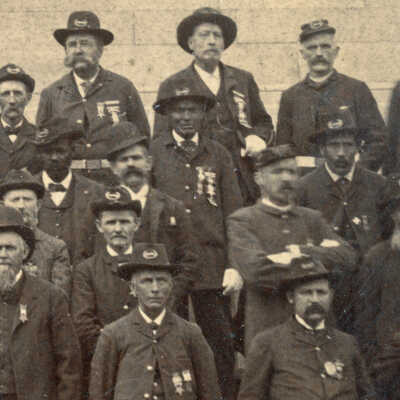
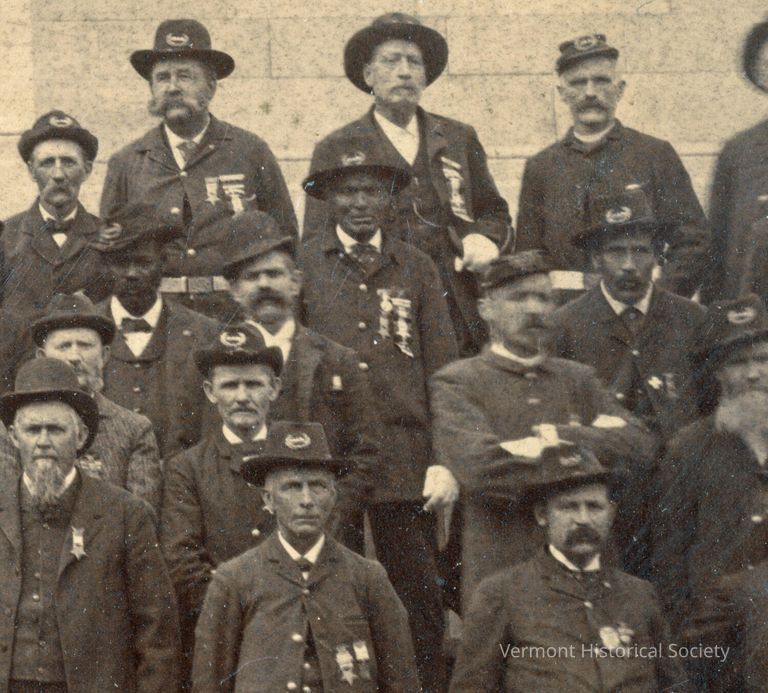
Civil War Soldiers
Name/Title
Civil War Soldiers
Description
Many historians talk of the out-sized contribution of Vermont soldiers to the Union cause of the American Civil War. Often lost from that conversation is the great sacrifice made by Black Vermonters, fighting in this war against the institution of slavery. With a black population of only 709 at the outbreak of the war, 152 men volunteered their services - over 20% of the total population of men, women, and children. You won't see their names on rosters of Vermont regiments or cavalry troops as the segregated army restricted black soldiers to specific non-Vermont units.
Black Vermonters from throughout the state joined the United States Colored Infantry Regiments and the 54th and 55th Massachusetts regiments. They came from all walks of life and a variety of backgrounds. Many were generational Vermonters while others were former slaves or children of former slaves.
They served under Grant in the Wilderness, they manned the siege lines of Charleston, they attacked Fort Harrison at Petersburg, they held off Confederate forces after the defeat at Oultsee, Florida, and they were present at Lee's surrender at Appomattox. After the war, they were denied a quick trip home and instead assigned to the swamps of the Texas-Mexico border.
Many troops eventually returned to Vermont while others made lives elsewhere. Black veterans can be found on Vermont Grand Army of the Republic rolls and listed on some town memorials. The linked resources provide specific information on known Black Vermont Civil War soldiers.
Black Vermonters from throughout the state joined the United States Colored Infantry Regiments and the 54th and 55th Massachusetts regiments. They came from all walks of life and a variety of backgrounds. Many were generational Vermonters while others were former slaves or children of former slaves.
They served under Grant in the Wilderness, they manned the siege lines of Charleston, they attacked Fort Harrison at Petersburg, they held off Confederate forces after the defeat at Oultsee, Florida, and they were present at Lee's surrender at Appomattox. After the war, they were denied a quick trip home and instead assigned to the swamps of the Texas-Mexico border.
Many troops eventually returned to Vermont while others made lives elsewhere. Black veterans can be found on Vermont Grand Army of the Republic rolls and listed on some town memorials. The linked resources provide specific information on known Black Vermont Civil War soldiers.
Relationships
Related Publications
Men of Color, To Arms!
Publication
Entry/Object ID
1.2.7
Web Links and URLs
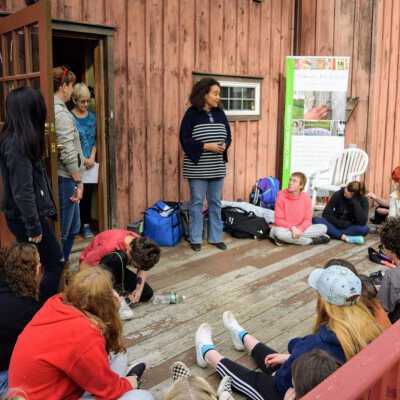
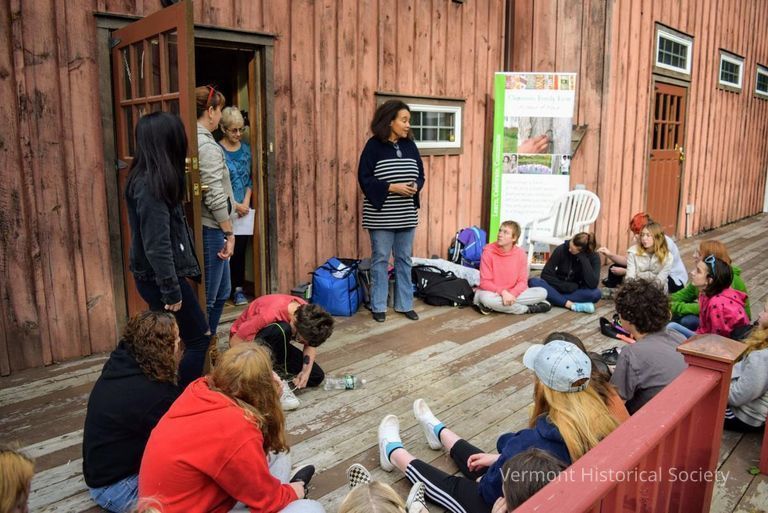
Clemmons Family Farm (est. 1962)
Name/Title
Clemmons Family Farm (est. 1962)
Description
Established: 1962
One of the few black-owned farms in Vermont and now a center for celebration, support, and study of the African and African-American diaspora in our community.
One of the few black-owned farms in Vermont and now a center for celebration, support, and study of the African and African-American diaspora in our community.
Biographical Information
Biography
When Dr. Jackson and Lydia Clemmons moved to Vermont to take jobs at Mary Fletcher Hospital and UVM (now UVM Medical Center), they opted to purchase, restore, and work a historic farm in Charlotte, Vermont. They raised their children on the farm and served in multiple leadership and civic roles in their community.
In 2017 only 0.4% of farms in the United States were black owned. Only 17 of 7,000 farms in Vermont are black owned. Clemmons Family Farm represents this small percentage and witnesses to the 93% loss of black-owned land to racism and discrimination throughout the course of the 20th century.
In 2015 the family started an organization that will gradually take over operation of the farm, both as black equity in the agricultural sector but also as a center for celebrating and supporting the African and African-American American diaspora through education, program, and exhibits.
Clemmons Family Farm programs will include: Tours of the Historic Farm; educational talks and demonstrations; cooking classes and pop-up meals; music, dance, and theater performances; art exhibits and cultural events; book talks and literary arts events; holistic health and healing events; on-Farm K-12 field trips and in-classroom programs; and family story-telling that spans 150 years of African-American history.
Entry/Object ID
1.2.27
Web Links and URLs
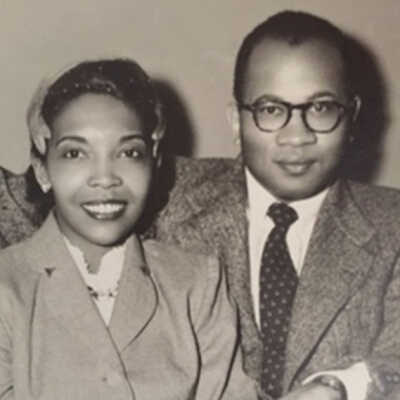

Clemmons, Dr. Jackson Joshua Walter (b. 1923)
Name/Title
Clemmons, Dr. Jackson Joshua Walter (b. 1923)
Description
Born: March 24, 1923 in Beloit, Wisconsin
Celebrated pathologist and biochemist moved to Vermont in 1962 where he joined the faculty of the UVM Medical College. He was only the second African-American on the medical school faculty. With his wife Lydia, he bought, restored, and worked a farm in Charlotte - now the non-profit Clemmons Family Farm.
Celebrated pathologist and biochemist moved to Vermont in 1962 where he joined the faculty of the UVM Medical College. He was only the second African-American on the medical school faculty. With his wife Lydia, he bought, restored, and worked a farm in Charlotte - now the non-profit Clemmons Family Farm.
Biographical Information
Education
BA, MA, PhD., University of Wisconsin
MD, Western Reserve University
Biography
Born in Beloit, Wisconsin, Jackson Clemmons attended the University of Wisconsin–Madison, earning a BS, MS, and PhD in biochemistry. As the first African American student in the biochemistry department, he paved the way for young African American scientists and premedical students to follow.
During his schooling, Clemmons worked as a research assistant, associate, or fellow in laboratories including the University of Wisconsin, the Karolinska Institute of Biophysics and Cell Research in Stockholm, and the Sloan Kettering Institute for Cancer Research in New York. At the University of Wisconsin, Clemmons worked with Karl Paul Link as a laboratory assistant involved in the development of the anticoagulants Dicoumarol and Warfarin.
After completing his doctorate, Clemmons enrolled in Western Reserve University School of Medicine, receiving his Doctor of Medicine in 1961. He won two American Cancer Society postdoctoral fellowships as well as a highly competitive Helen Hay Whitney Fellowship, which he utilized for research at both Western Reserve and at the University of Vermont Medical School, where he was appointed an assistant professor of pathology in 1962.
At UVM, Dr. Clemmons often designed and built his own research equipment. As a pathologist and the second African American on the UVM medical school faculty, he advocated for recruitment strategies to attract and retain more students and faculty of color. He served as an advisor to several national institutes, including the Agency of Housing and Urban Development and the National Institutes of Health.
When he and his wife Lydia, a nurse anesthetist, arrived in Vermont in 1962 they purchased a 148-acre farm in Charlotte. Friends, family, and colleagues questioned this purchase and lifestyle choice, but over time, the property became a center for community and a rich environment for their five children. Doctor and Mrs. Clemmons served as co-presidents of the Charlotte Central School PTA, and Dr. Clemmons served as school director and as vice chair of the Champlain Valley Union High School board. Together Doctor and Mrs. Clemmons travelled and volunteered in hospitals and medical centers throughout Africa from 1984 to 2005 and pursued their love of learning about the art and cultures of the continent.
Currently in transition from a private holding to a nonprofit, the Clemmons Family Farm features six historic buildings dating to the late 1700s and mid-1800s, all beautifully improved and hand-restored over five decades by Dr. Clemmons—whose grandfather taught him the skills of the carpentry trade—and a small team of local artisans.
Occupation
Doctor
Researcher
Farmer
Entry/Object ID
1.2.21
Web Links and URLs


Clemmons, Francois Scarborough (b. 1945)
Name/Title
Clemmons, Francois Scarborough (b. 1945)
Description
Born: April 23, 1945 in Birmingham, Alabama
Singer, actor, teacher best known for portraying "Officer Clemmons" on Mister Roger's Neighborhood from 1968 to 1993.
Singer, actor, teacher best known for portraying "Officer Clemmons" on Mister Roger's Neighborhood from 1968 to 1993.
Biographical Information
Education
BA, Oberlin College
MFA, Carnegie Mellon University
Biography
Born in Birmingham, Alabama, and raised in Youngstown, Ohio, Francois Clemmons found his singing voice at a very early age. Learning spirituals from his mother, he sang in church and at local functions, even directing the choir at the young age of ten. He pursued music at both Oberlin College and Carnegie Mellon University.
He earned a position in the Metropolitan Opera Studio and went on to perform with numerous companies and orchestras including: the New York City Opera, the Los Angeles Civic Opera, the Washington Civic Opera, the Cleveland Orchestra, the Pittsburgh Symphony, and the Philadelphia Orchestra. In 1976 he won a Grammy Award for his recording of "Porgy and Bess."
Francois Clemmons is probably best known for his protrayal of Officer Clemmons on the PBS childrens' show Mister Roger's Neighborhood. His recurring role was one of the firsts for an African American in children's television. In a ground-breaking 1969 episode he shared a wading pool with Fred Rogers and used Rogers' towel to dry his feet. At the time, many community pools banned Black people from swimming at the same time as whites.
In 1997 Clemmons moved to Middlebury, Vermont, where he joined the Middlebury College faculty as the Alexander Twilight Artist in Residence and the director of the Martin Luther King Spiritual Choir. A fixture on campus and in the community, he inspired many students personally and professionally.
Though he retired in 2013, Francois Clemmons has embarked on a writing career, publishing his autobiography in 2020 as well children's books, poetry, musicals, and a volume of spirituals.
Occupation
Singer
Actor
Teacher
Writer
Entry/Object ID
1.2.20
Web Links and URLs


Cole, Robert Arthur (1920-1968)
Name/Title
Cole, Robert Arthur (1920-1968)
Description
Born: March 8, 1920 in Northfield, Vermont
Died: August 19, 1968 in Baltimore, Maryland
Robert Cole was the only Vermonter to serve with the famed Tuskegee Airmen of WWII.
Died: August 19, 1968 in Baltimore, Maryland
Robert Cole was the only Vermonter to serve with the famed Tuskegee Airmen of WWII.
Biographical Information
Education
Northfield High School
Biography
Robert Arthur Cole was born and raised in Northfield, Vermont by his mother, Martha, who ran a small B&B out of their home for black travelers, and his father, Alonzo, an amateur musician. Robert was one of five children, three boys and two girls, all of whom attended local schools. According to his yearbook, Arthur participated in drama, basketball, chorus, and played the guitar in the school dance band, the Blue Jackets.
After graduation Cole worked for a time in a shoe repair shop and as a porter before enlisting in the Army. With WWII well underway, he was assigned to flight training at Tuskegee, Alabama as part of 332nd Fighter Group. A segregated unit, this group, along with the 447th Bomber Group, became known as the Tuskegee Airmen. Though Cole was fully trained on U.S. Fighters as part of the 99th Squadron, he was never deployed oversees. Finishing his training near the end of the war, he spent his final year of service barnstorming the United States performing with the Army Air Force demonstration team.
After the war, Cole returned home to Northfield and purchased the shoe repair shop he worked at prior to the war. He retrained on civilian aircraft and continued to fly out of the Barre-Montpelier Airport, now known as the Edward F. Knapp State Airport, in Berlin.
In 1949 he married Irena Elizabeth Pombar of Berlin, a second marriage for both. As an interracial marriage, the union was quite rare for its time and lasted until 1954. Cole lived in Northfield until the mid-1960s when he moved to the Baltimore, Maryland area. He died in Baltimore in 1968 at only 48-years-old.
Occupation
Pilot
Shoemaker/Cobbler
Entry/Object ID
1.2.22
Web Links and URLs

Dinah (c. 1753 - 1809)
Name/Title
Dinah (c. 1753 - 1809)
Also Known As
Dinah White
Description
Born: circa 1753
Died: 1809 in Windsor, Vermont
Enslaved by Judge Stephen Jacob of Windsor, Vermont. The subject of a Supreme Court Case that probed the Vermont Constitutional ban on adult slavery.
Died: 1809 in Windsor, Vermont
Enslaved by Judge Stephen Jacob of Windsor, Vermont. The subject of a Supreme Court Case that probed the Vermont Constitutional ban on adult slavery.
Biographical Information
Biography
Dinah was probably born into slavery around the year 1753. Details of her life are only known through an unfortunate Vermont Supreme Court case that revolved around the Vermont Constitution's ban on adult slavery.
In 1783 Stephen Jacob, an attorney from Windsor, Vermont, purchased Dinah from Jotham White of Charlestown, New Hampshire. Jacobs brought her to Windsor to work in his household. She stayed in the Jacobs home until 1800 when she started to lose her eyesight and suffered from other health issues. Unable to care for herself, she was expelled from the house to be cared for by the overseer of the poor for Windsor.
The town select board, operating as the overseers of the poor, balked at taking care of Dinah, insisting that Stephen Jacob care for her as she was enslaved and not a citizen of the town. The argument reached a point where a case was brought before the Vermont Supreme Court in 1802.
By this point Stephen Jacob served as one of the three Vermont Supreme Court justices. He recused himself from the proceedings, leaving the decision to Judge Jonathan Robinson and Judge Royall Tyler.
The town argued that Jacob purchased Dinah and enslaved her in his home for almost twenty years. As a slave, she would not be afforded the public charity benefits (support of the poor) offered citizens of Windsor. The town tried to enter into evidence the signed bill-of-sale between Jacobs and White from 1783.
Jacob argued that she was not a slave, but a servant, and that in 1800 she started taking jobs from other people so was not beholden to him for responsibility or care. His lawyers also argued to disallow the bill-of-sale from evidence since Vermont banned adult slavery in its Constitution and the bill-of-sale would have no legal standing in Vermont.
Ultimately the Supreme Court ruled in Jacob's favor, stating that since Vermont banned adult slavery, Dinah stopped being enslaved as soon as she came to Vermont. This decision ran counter to Vermont's fugitive slave act of 1793 that stated people enslaved outside Vermont remained enslaved, even if they crossed into Vermont and must be returned to their owners.
The legal gymnastics of this case did not change the lived experience of Dinah as an enslaved person in a state that purportedly outlawed slavery.
The town of Windsor tried unsuccessfully to expel her from town on a couple of occasions, but must have eventually had a change of heart as the overseers paid someone to "attend to Judge Jacob's Dinah in her last sickness." The town paid for her burial in the local cemetery.
Entry/Object ID
1.2.14
Web Links and URLs

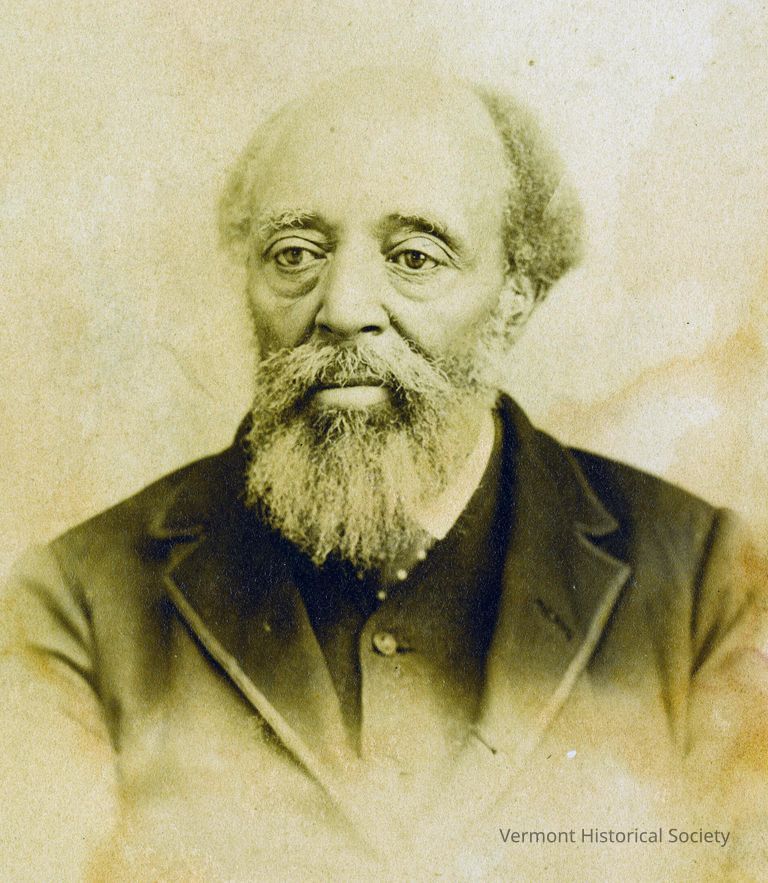
Freeman, Martin Henry (1826-1889)
Name/Title
Freeman, Martin Henry (1826-1889)
Description
Born: May 11, 1826 in Rutland, Vermont
Died: May 26, 1889 in Monrovia, Liberia
Primary Residence: Rutland
Graduating as salutatorian of his Middlebury College class, Martin Henry Freeman went on to become the president of Allegheny Institute, the first black college president in the United States.
Died: May 26, 1889 in Monrovia, Liberia
Primary Residence: Rutland
Graduating as salutatorian of his Middlebury College class, Martin Henry Freeman went on to become the president of Allegheny Institute, the first black college president in the United States.
Biographical Information
Education
BA, Middlebury College (1849)
MA Honorary, Middlebury College (1852)
Biography
Martin Henry Freeman was born to Charles and Patience Freeman in Rutland, Vermont in 1826. He prepared for college with Rev. William Mitchell before matriculating at Middlebury College in 1845. He graduated in 1849 as the salutatorian of his class.
In 1850 Freeman became a junior professor at Allegheny Institute (now Avery College) in Pittsburgh, Pennsylvania, the first black college professor in the United States. He was eventually appointed president of the school, the first black college president in the United States.
Over time Freeman came to feel that the United States was not a healthy place for black people to live and came to advocate for emigration to Africa. In 1863 he moved to Liberia where he taught mathematics at Liberia College in Monrovia. In 1868 he was appointed college president and served in that capacity until his death in 1889.
Occupation
Professor
College President
Entry/Object ID
1.2.5
Web Links and URLs

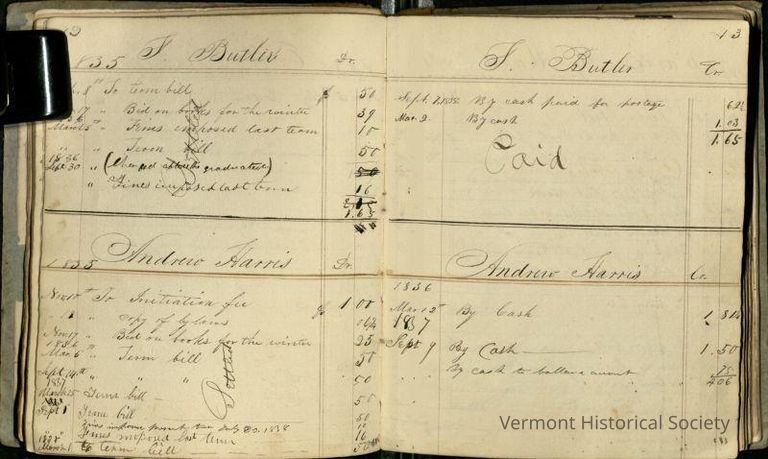
Harris, Rev. Andrew (1814-1841)
Name/Title
Harris, Rev. Andrew (1814-1841)
Description
Born: 1814 in New York
Died: December 1, 1841 in Philadelphia, Pennsylvania
First black graduate of the University of Vermont and ardent abolitionist preacher.
Died: December 1, 1841 in Philadelphia, Pennsylvania
First black graduate of the University of Vermont and ardent abolitionist preacher.
Biographical Information
Education
Geneva Lyceum
UVM (1838)
Biography
Born to a very young mother in New York state in 1814, Andrew Harris was adopted and raised by white Presbyterian minister and his wife along with their nine natural children in Cayuga, New York. This location was one of the epicenters of revivalist thought and action. He attended church school, even teaching sections himself. Supported by his family, he attended the Geneva Lyceum, a college and ministry preparatory school.
In 1834 he applied to Union College and then Middlebury College, receiving rejections from both due to the current political environment revolving around the "Negro riots" of the summer of that year. Ultimately, he ended up applying for and being accepted as the first black student at the University of Vermont.
His time in Burlington was not pleasant, with extreme racism at every juncture of his academic journey. The academic records of his time often list him last on student rolls, even though all other students were listed alphabetically. His experiences were later recounted by his friend Alexander Mann as well as Frederick Douglass. However, he persisted and attended all of his exams, attaining the requirements of graduation in 1838. At the time, all graduates presented an oration during the graduation ceremony. According to a preprinted schedule, Harris was set to deliver his oration 14th out of 24 students. By all accounts he was awarded his degree, but barred from speaking at the event.
He quickly became very active in the abolitionist movement and advocated for the immediate abolition of slavery with a political, rather than moral, approach. He was not in favor of the Colonization Movement, popular in Vermont, that promoted the resettlement of African-Americans in Liberia. He moved to New York and later Philadelphia where he gained notoriety for both his writing and speeches.
In 1841 he was ordained a Presbyterian minister in Philadelphia with a promising career ahead of him. Tragically, he died of a fever that December at the young age of 27.
Occupation
Abolitionist
Minister
Entry/Object ID
1.2.24
Web Links and URLs
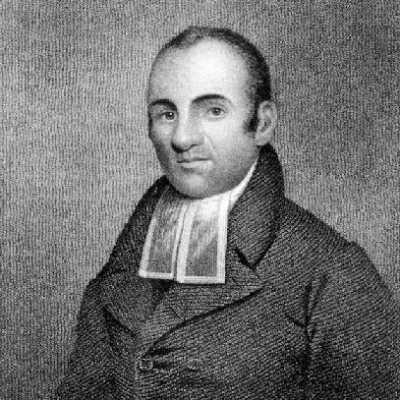

Haynes, Rev. Lemuel (1753-1833)
Name/Title
Haynes, Rev. Lemuel (1753-1833)
Description
Born: July 18, 1753 in West Hartford, Connecticut
Died: September 28, 1833 in South Granville, New York
A veteran of the American Revolution, Lemuel Haynes was the first black man to be ordained as a minister in the United States. He served the West Rutland Congregational Church for 30 years.
Died: September 28, 1833 in South Granville, New York
A veteran of the American Revolution, Lemuel Haynes was the first black man to be ordained as a minister in the United States. He served the West Rutland Congregational Church for 30 years.
Biographical Information
Education
Honorary Masters, Middlebury College (1804)
Biography
Lemuel Haynes was born on July 18, 1753 in West Hartford, Connecticut, to a white mother and black father. The identity of his mother has long been the subject of debate, either servant Lucy (or Alice) Finch or a member of the prominent Goodwin family.
At the age of five months, Lemuel Haynes was indentured to Deacon David Rose, a blind farmer from Granville, Massachusetts. Part of the indenture required Rose to provide Haynes's education. Haynes was raised by the Rose family in a strict Calvinist household where he gained an affinity for religious thought.
Haynes' indenture expired in 1774 and he joined the minutemen of Granville. In 1775, he marched with his militia company to Roxbury, Massachusetts, following the news of the Battles of Lexington and Concord and in 1776, he garrisoned the recently captured Fort Ticonderoga.
During the American Revolution, Haynes began to write extensively, criticizing the slave trade and slavery. He continued these activities after the war, and also began to prepare sermons, family prayers and other theological works. Haynes argued that slavery denied black people their natural rights to "Life, Liberty and the pursuit of happiness".
After his military service, Haynes studied theology in Connecticut and Massachusetts and received a license to preach in 1780. He served his home church in Middle Granville while also serving as a missionary in the Republic of Vermont. At this time he married a white school teacher named Elizabeth Babbitt.
In 1785 Haynes became the first black man ordained in the United States. From 1785 to 1788 he served as the pastor of the Hemlock Congregational Church in Torrington, Connecticut. From Torrington he moved to West Rutland, Vermont where he served as pastor of the West Parish Church (now the West Rutland United Church of Christ) for 30 years. While in West Rutland, Haynes received an honorary Masters degree from Middlebury College at its second commencement in 1804. This was only the fourth degree given by the school and the first to an African American.
Haynes continued to write and speak about slavery. Unlike many of his north abolitionist contemporaries who preferred expatriation of black Americans to Africa, he strongly advocated for abolition and the full integration of races in the United States. In addition to his abolitionist views, he was a staunch Federalist which led, in part, to his dismissal from the West Rutland Church in 1818. He served the Manchester, Vermont, Congregational Church for three years before settling at the South Granville, New York church from 1822 to his death in 1833.
Occupation
Minister
Entry/Object ID
1.2.2
Web Links and URLs
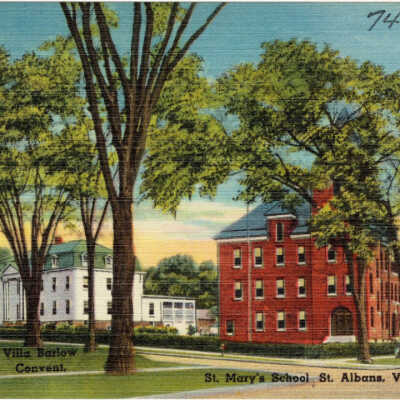
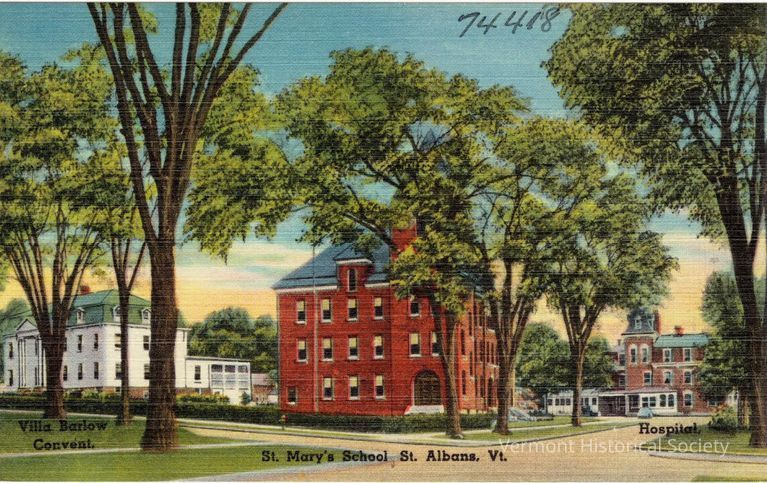
Healy, Eliza (1846-1919)
Name/Title
Healy, Eliza (1846-1919)
Also Known As
Sister Saint Mary Magdalene
Description
Born: December 23, 1846 in Macon, Georgia
Died: September 13, 1919 in Montreal, Quebec
Mother superior of Villa Barlow in St. Albans, Vermont, the first African-American mother superior of a Catholic convent in North America.
Died: September 13, 1919 in Montreal, Quebec
Mother superior of Villa Barlow in St. Albans, Vermont, the first African-American mother superior of a Catholic convent in North America.
Biographical Information
Education
Congregation of Notre Dame, Montreal
Biography
Eliza Healy was born into slavery in Macon, Georgia in 1846. Her biracial mother, Mary Eliza Clark, lived as a slave and domestic partner to her father, an Irish immigrant named Michael Morris Healy. Eliza was the youngest of 10 children born to this couple. Michael and Mary both died in 1850. At this time only three youngest children were living at home, the older children had all relocated to northern New York, possibly free - the Healy family dynamic is unknown. Eliza and her two siblings moved north to join them.
Though her father was Catholic, she was not baptized into the Catholic Church until 1851. She and her sister Josephine were educated in schools operated by the Congregation of Notre Dame in Saint-Jean-sur-Richelieu and Montreal. After completing her education in 1861 she moved first to her brother Eugene's home in Boston and then later to her brother James' home in Newton. James was an ordained Catholic priest and would later go on to become the first African-American bishop in the U.S. Eliza traveled with James to Europe and the Middle East. When the panic of 1873 destroyed his finances she decided to enter a religious order.
In 1874 Eliza Healy entered the Congregation of Notre Dame as a novitiate, pronouncing her vows in June of 1876. Throughout her early years as a nun, she taught in Montreal, Brockville, Ontario, and Sherbrook, Quebec. In 1895, following administrative roles in other convents and schools, she was appointed superior of a convent in Huntingdon, Quebec, the first African-American to hold this title. She held various leadership and teaching roles throughout Quebec before being assigned to the Villa Barlow in St. Albans, Vermont.
The Villa Barlow was a convent and Catholic school. Eliza Healy, now known as Sister Saint Mary Magdalene, served as Mother Superior and Headmistress of the institution, the first African-American to hold either of these roles in the United States. She stayed in St. Albans from 1903 to 1918 when church rules required her to move to another house. She saved the school from mounting debt and improved the curriculum and teaching methods. Health and hygiene of students was top priority for her tenure.
In 1918, per the church's fifteen-year limit on superiors' terms, she left St. Albans for Notre Dame Academy on Staten Island. After only eight months her health declined and she moved back to the mother house in Montreal where she died in 1919.
Occupation
Nun
Teacher
Administrator
Entry/Object ID
1.2.6
Web Links and URLs


Henderson, Rev. George Washington (1850-1936)
Name/Title
Henderson, Rev. George Washington (1850-1936)
Description
Born: November 11, 1850 in Clark County, Virginia
Died: February 3, 1936 in Xenia, Ohio
Born into slavery, George Washington Henderson accompanied a Vermont Officer home from the Civil War and ended up graduating first in his class from UVM. He was the first black member of Phi Beta Kappa.
Died: February 3, 1936 in Xenia, Ohio
Born into slavery, George Washington Henderson accompanied a Vermont Officer home from the Civil War and ended up graduating first in his class from UVM. He was the first black member of Phi Beta Kappa.
Biographical Information
Education
BA, UVM (1877)
MA, UVM (1880)
BDiv, Yale (1883)
DDiv Honorary, UVM (1896)
Biography
George Washington Henderson was born into slavery in Clark County, Virginia in 1850. Little is known of of his early life. Evidently freed during the Civil War, he became the manservant of a Vermont Infantry officer and accompanied him back to Vermont.
He attended Underhill Academy and then Barre Academy, graduating in 1873. He earned his BA, first in his class from the University of Vermont in 1877 and was inducted in Phi Beta Kappa, the first African American to receive this honor. He went on to finish a masters at UVM in 1880 and a Bachelor's of Divinity from Yale in 1883. He studied further in Berlin, Germany.
During and after his school years he served as principal of Jericho Academy, Craftsbury Academy, and Newport Graded School. In 1888 he left Vermont for New Orleans where he became pastor of the Central Congregational Church. In 1890 he became chair of the department of theology at Straight (now Dillard) University. In 1896 he journeyed back to Vermont to receive an Honorary Doctor of Divinity degree from UVM.
From 1904 to 1909 he served as Dean of Theology at Fiske University in Nashville, Tennessee. In 1909 he moved to Xenia, Ohio where he served the rest of his career as professor of Latin, Greek, and Ancient Literature at Wilberforce University.
George Washington Henderson produced a couple of noteworthy works. The "First Memorial Against Lynching," published in 1894 and sent to the Louisiana legislature was the first formal protest against lynching in the United States. His pamphlet documenting the actions of black soldiers during the Spanish-American War was the only contemporary account written of these men.
Occupation
Principal
Pastor
Professor
Entry/Object ID
1.2.8
Web Links and URLs
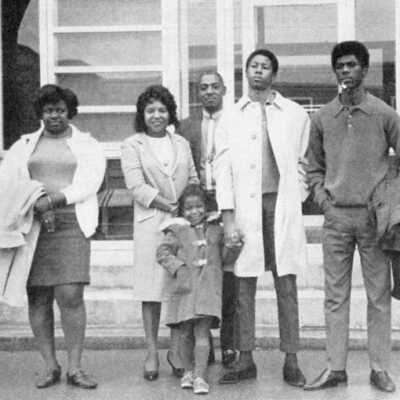
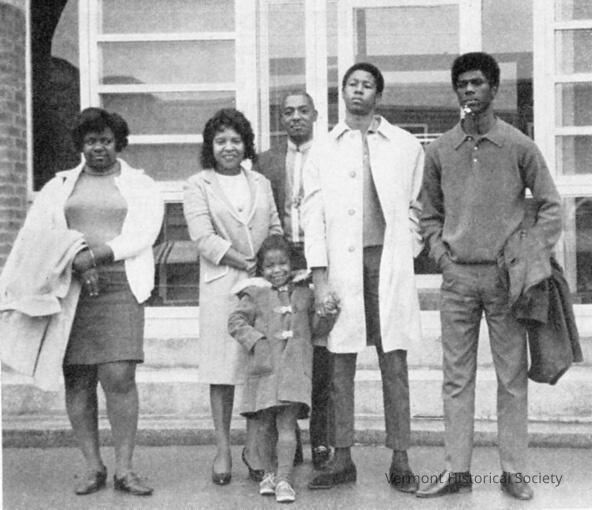
Johnson, Rev. David Lee Henry (1929-1988)
Name/Title
Johnson, Rev. David Lee Henry (1929-1988)
Description
Note: This entry is based on the published report of the Gubernatorial Board of Inquiry into the affair. Some, including the incoming Deane Davis administration, have questioned the procedure and findings of the inquiry.
Born: November 13, 1929 in Coatesville, Pennsylvania
Died: October 31, 1988 in Los Angeles, California
Baptist minister who arrived in Irasburg, Vermont in 1968 and soon after, a group of young men shot at his house. Rather than investigate the shooter, the police investigated Rev. Johnson, ultimately charging him with adultery. Would later be called the Irasburg Affair.
Born: November 13, 1929 in Coatesville, Pennsylvania
Died: October 31, 1988 in Los Angeles, California
Baptist minister who arrived in Irasburg, Vermont in 1968 and soon after, a group of young men shot at his house. Rather than investigate the shooter, the police investigated Rev. Johnson, ultimately charging him with adultery. Would later be called the Irasburg Affair.
Biographical Information
Biography
In 1968, Rev. David Lee Johnson moved his family to Irasburg, Vermont to escape the racial unrest of their former home in California. In addition to his wife Ophelia, his sons David and George and daughter Brenda and her child Yvette made the trip to Vermont. Family friend Barbara Lawrence and her daughter also joined them.
On the night of July 19th, a group of young people drove past the Johnson's house and fired a gun at the residence. Rev. Johnson, a military veteran, fired back at the car with his revolver, causing the assailants to flee.
The state police as well as the Attorney General quickly responded to the Johnson home and promised a thorough investigation. A state police guard was placed at the house in meantime. The perpetrator was quickly identified as Larry Conley, a local man home on leave from the Army. He had previously verbally assaulted black children at a local beach visiting Vermont through a program instituted by Governor Hoff and the mayor of New York. Conley's father was a well-known local with connections in law enforcement. The state police dragged their feet on an arrest and withheld information from the Attorney General.
With the aid of local newspapers, the troopers assigned to the case started investigating the background of the victim, Rev. Johnson. During the course of the investigation, one of the troopers assigned to guard the Johnson house reported that he witnessed Rev. Johnson engaging in sexual activity with house-guest Barbara Lawrence, a white woman. While Larry Conley was arrested, he was only charged with breach-of-the-peace and quickly released. Rev. Johnson and Barbara Lawrence were arrested and charged with breaking the archaic Vermont law of adultery. Their charges, and the possible consequences were much greater than those of the man that fired a gun into their home.
Barbara Lawrence was encouraged to plead no contest as long as she left the state. She quickly returned to California. Rev. Johnson refused to plead at all with his attorney as well as members of state Government contending racism in the legal action. All the while, the local newspapers published editorials regarding Rev. Johnson's past and relations with white women. The trooper in charge, as well as a state's attorney, without the knowledge of the Attorney General, went so far as to fly to California to compel Barbara Lawrence to return so they could have her testify. She refused and a California judge supported her decision while chastising the Vermonters for the whole affair.
Ultimately the charges against Rev. Johnson were dropped, but the impact on him and his family was immense. He ultimately moved his family back to California and expressed no interest in ever returning to Vermont. He eventually became a California State Trooper and served in the Los Angeles area until his death in 1988.
A board of inquiry was appointed by Governor Philip H. Hoff and chaired by former governor and U.S. District Judge Ernest Gibson Jr. The board concluded that the state police acted inappropriately and in a racist way by delaying the shooting investigation and moving quickly with the adultery charges. Though ordered by the governor, Public Safety Commissioner E. A. Alexander refused to discipline any of his troopers that were involved in the case. Governor Hoff left office two weeks later and with the change of administration no one was disciplined.
The incident became known as the Irasburg Affair and inspired Howard Frank Mosher's book, "A Stranger in the Kingdom," which was later turned into a feature film by Jay Craven.
Entry/Object ID
1.2.11
Web Links and URLs
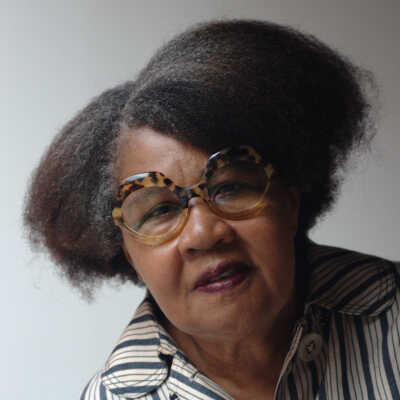
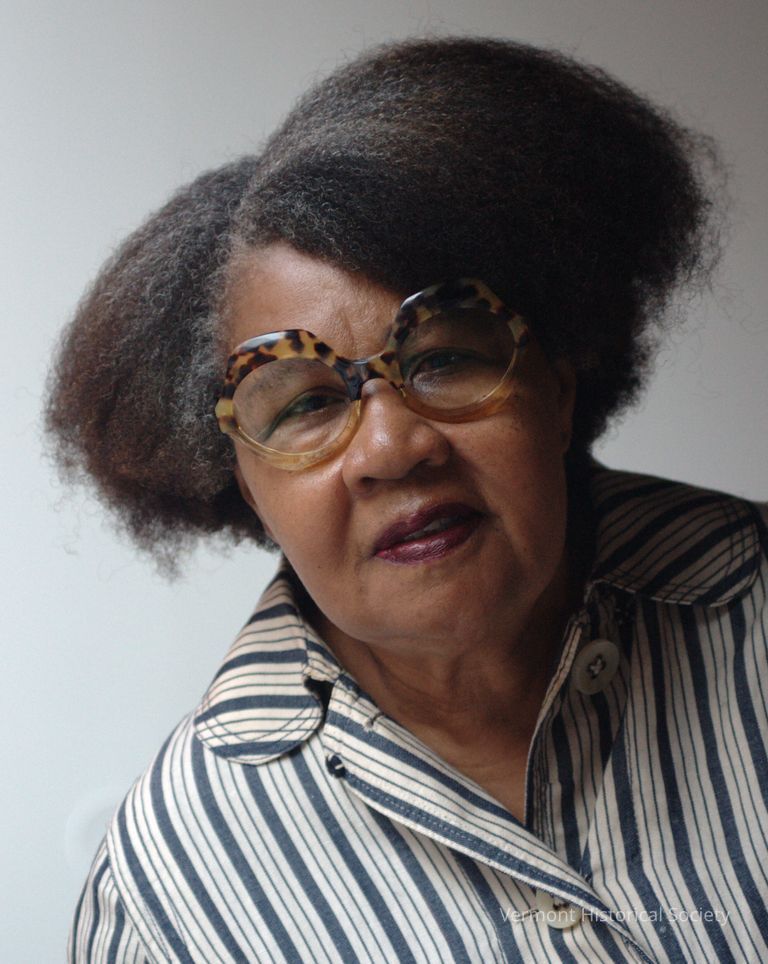
Kincaid, Jamaica (b. 1949)
Name/Title
Kincaid, Jamaica (b. 1949)
Also Known As
Elaine Potter Richardson
Description
Born: May 25, 1949 in St. John's Antigua
Primary Residence: Bennington
Wrote for the New Yorker for almost twenty years and is the author of numerous short stories and books including, "At the Bottom of the River" (1984) and "Lucy" (1990). Visiting lecturer at Harvard University.
Primary Residence: Bennington
Wrote for the New Yorker for almost twenty years and is the author of numerous short stories and books including, "At the Bottom of the River" (1984) and "Lucy" (1990). Visiting lecturer at Harvard University.
Biographical Information
Education
Franconia College (2 years)
Honorary Doctorate of Humane Letters from Wesleyan University (2008)
Biography
Jamaica Kincaid was born in St. John's, Antigua as Elaine Potter Richardson in 1949. When she finished school, she moved to the United States to be an au pair in New York and took writing classes at the New School for Social Research.
Kincaid won a full scholarship to Franconia College in New Hampshire but only attended the school for two years. She took the pen name Jamaica Kincaid in 1973 and got a job as a staff writer at the New Yorker in 1976. She stayed with the New Yorker until 1995, even though she and her husband, Allen Shawn, moved to Bennington, Vermont in 1985 to teach at Bennington College.
Her writing talents developed over the years and she has published numerous short stories, essays, and novels. Her works include: "At the Bottom of the River"(1984), "Annie John" (1985), "Lucy" (1990), "The Autobiography of My Mother" (1996), "My Brother" (1997), and "My Garden (Book)"(1999), in which she describes her garden in Bennington, Vermont. Her most recent works are "Talk Stories" (2001), "Seed Gathering Atop the World" (2002), and "Among Flowers: A Walk in the Himalayas" (2005).
Kincaid is currently a visiting lecturer on African and African-American Studies and on English and American Literature and Language at Harvard University. She received an Honorary Doctorate of Humane Letters from Wesleyan University in 2008.
Occupation
Author
Lecturer
Entry/Object ID
1.1.51
Web Links and URLs
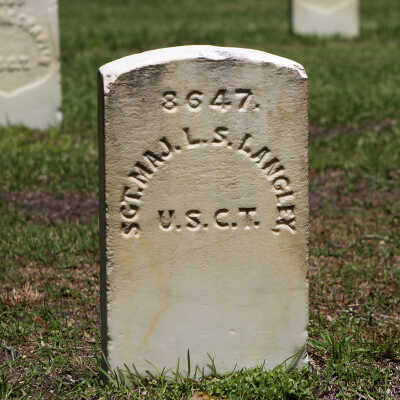
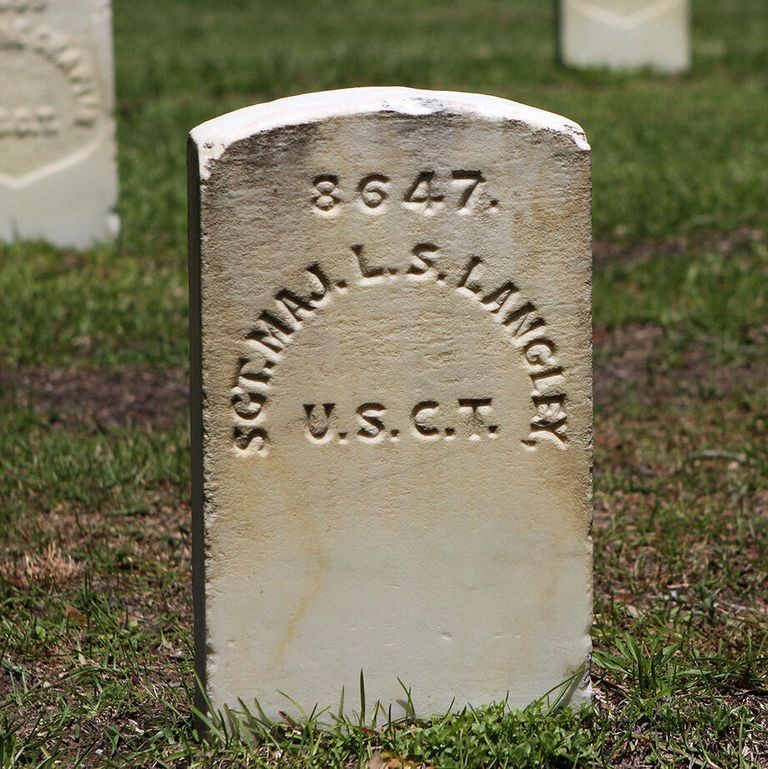
Langley, Louden Shubael (1838-1881)
Name/Title
Langley, Louden Shubael (1838-1881)
Also Known As
Description
Born: 1838 in Huntington, Vermont
Died: June 28, 1881 in Beaufort, South Carolina
Prolific letter writer born to large family in Huntington and Hinesburg, Vermont. Joined the 54th MA Volunteer Infantry Regiment during the Civil War. Attained rank of Sergeant-Major in the 33rd U.S. Colored Infantry Regiment. Stayed in Beaufort, South Carolina after the war. Served as tax auditor, school commissioner and state constitutional convention representative during Reconstruction.
Died: June 28, 1881 in Beaufort, South Carolina
Prolific letter writer born to large family in Huntington and Hinesburg, Vermont. Joined the 54th MA Volunteer Infantry Regiment during the Civil War. Attained rank of Sergeant-Major in the 33rd U.S. Colored Infantry Regiment. Stayed in Beaufort, South Carolina after the war. Served as tax auditor, school commissioner and state constitutional convention representative during Reconstruction.
Biographical Information
Biography
Louden Shubael Langley was born into a large, extend family of Langleys and Clarks amongst the hills of Huntington and Hinesburg, Vermont. Educated in local schools, Langley made a name for himself writing extensive letters to local newspapers regarding abolition, colonization, and southern secession.
In 1863, he and two of his brothers enlisted in the 54th Massachusetts Volunteer Infantry, an all black unit in the segregated Union Army. Vermont, due to population size, did not field any all-black units, so many black volunteers from Vermont were sent to Massachusetts to enlist. His service in this unit eventually brought him to the Sea Islands of South Carolina where he accepted a promotion and transfer to the 33rd U.S. Colored Infantry Regiment, made up almost exclusively of members of the Black 1st South Carolina Volunteer Infantry Regiment. His rank of Sergeant-Major was the highest afforded to black soldiers at the time.
The 33rd mustered out of service in January of 1866. Langley decided to stay in South Carolina, settling down in Beaufort with his wife and young daughter. They later had a son.
Louden Langley quickly took on leadership roles in the mostly black local government of Reconstruction-era South Carolina. He served as a teacher for the Freedman's Bureau, tax auditor and school commissioner in his home town. His role as tax auditor perhaps led him to invest in a number of properties sold at tax sales.
Langley was a member of the five-person delegation from Beaufort County to South Carolina's Constitutional Convention in Charleston. Secondary sources state that he fought hard for an equal and desegregated education clause in the new state constitution, something he would have been familiar with growing up in Vermont. This clause ultimately did not find its way into the constitution and by 1880, Reconstruction came to an end with African-Americans losing all their elected positions and power as the Jim Crow era dawned.
Louden Langley's last job was that of an assistant lighthouse keeper, perhaps at Hunting Island. He was only there for about one year as he died of unknown causes at the age of 42 in 1881. He's buried with other Civil War veterans in the Beaufort National Cemetery.
Occupation
Farmer
Soldier
Teacher
Tax Auditor
School Commissioner
Lighthouse Keeper
Entry/Object ID
1.2.26
Web Links and URLs
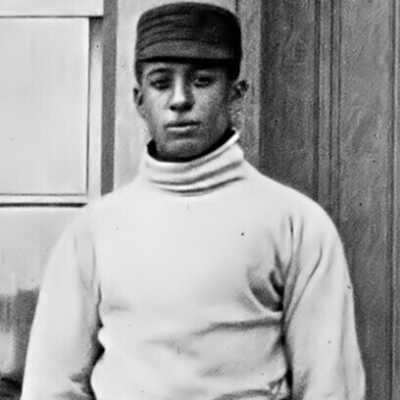
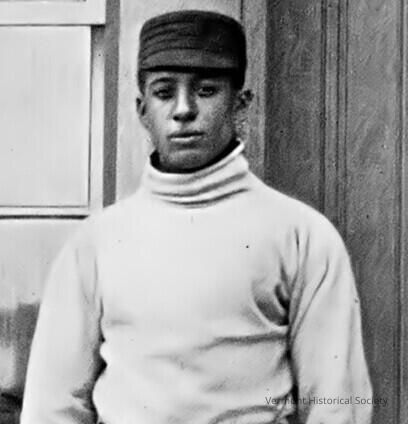
Matthews, William Clarence (1877-1928)
Name/Title
Matthews, William Clarence (1877-1928)
Description
Born: January 7, 1877 in Selma, Alabama
Died: April 9, 1928 in Washington, DC
On July 4, 1905, William Matthews started at second base for the Burlington Baseball Team of the Northern League. This assignment made him the only black player in all of professional baseball, with later historians calling him "the Jackie Robinson of his age." Matthews went on to a successful law career, eventually serving as an assistant U.S. Attorney General in the Coolidge administration.
Died: April 9, 1928 in Washington, DC
On July 4, 1905, William Matthews started at second base for the Burlington Baseball Team of the Northern League. This assignment made him the only black player in all of professional baseball, with later historians calling him "the Jackie Robinson of his age." Matthews went on to a successful law career, eventually serving as an assistant U.S. Attorney General in the Coolidge administration.
Biographical Information
Education
Tuskegee Institute
Philips Andover Academy
Harvard
Boston University Law School
Biography
William Clarence Matthews was born in Selma, Alabama and attended Tuskegee Institute under the direction of Booker T. Washington. Washington help Matthews gain admittance to Philips Andover Academy, where he was the only black student, and later Harvard University. At all three schools Matthews showed great skill at baseball, ultimately starting at short stop all four years at Harvard.
The summer after graduating Harvard, William Matthews was hired by the Burlington Baseball Club to be their starting second baseman in the Northern League. On July 4, 1905, he stepped onto the diamond at the old Burlington Athletic Field and broke the color barrier in professional baseball. He played the entire season and endured racism from fans and other players alike. When playing some teams, his manager had to move him to the outfield so that he wouldn't be intentionally spiked by white players sliding into second base. Players of southern background refused to take the field against him. During that summer, a rumor started that he would be hired to play for Boston's National League team, the Boston Beaneaters. This quickly ended when a number of southern teams stated they would refuse to play if he was hired.
That fall, Matthews left professional baseball to enroll at Boston University School of Law. He coached high school teams in Boston to put himself through school and ultimately passed the bar exam in 1908.
William Matthews served as the U.S. Attorney for Boston and the legal advisor to Marcus Garvey. When Calvin Coolidge ran for his first full-term as president, Matthews worked enthusiastically on his campaign. He was appointed an assistant attorney general and tried a number of high-profile cases before dying tragically of a perforated ulcer in 1928 at only 51 years old.
Occupation
Professional Baseball Player
Attorney
Entry/Object ID
1.2.23
Web Links and URLs

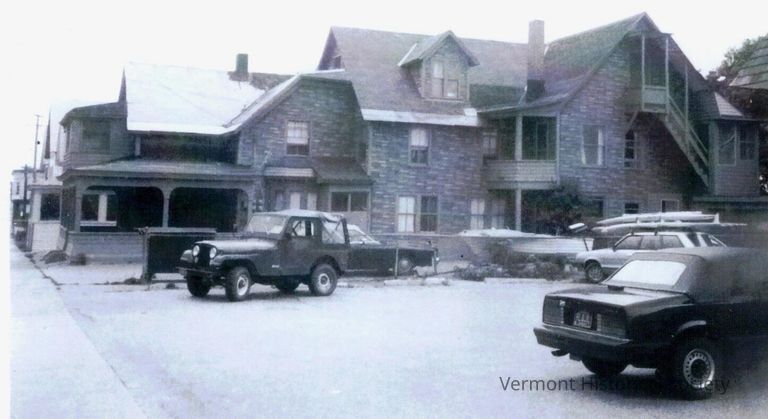
Pates Hotel (c. 1928-1966)
Name/Title
Pates Hotel (c. 1928-1966)
Also Known As
The Pates
Description
Established circa 1928
Clelati Harrison (1874-1957)
Frank Pate (1872-1950)
Established by Cleta (Clelati) Harrison King Pate and her husband Frank Pate in 1928, the building at 86-90 Archibald Street in Burlington served as a rooming house and hotel for a generation of Black travelers. The Pates Hotel was listed in every edition of "The Negro Motorist Green-Book" until its discontinuation in 1966.
Clelati Harrison (1874-1957)
Frank Pate (1872-1950)
Established by Cleta (Clelati) Harrison King Pate and her husband Frank Pate in 1928, the building at 86-90 Archibald Street in Burlington served as a rooming house and hotel for a generation of Black travelers. The Pates Hotel was listed in every edition of "The Negro Motorist Green-Book" until its discontinuation in 1966.
Entry/Object ID
1.2.28
Web Links and URLs
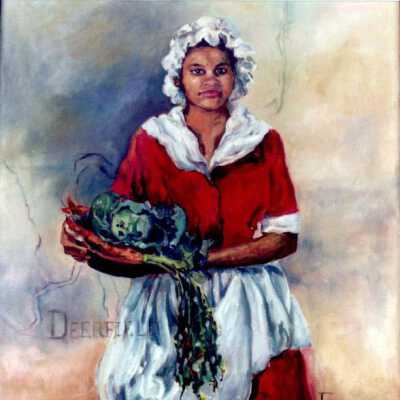

Prince, Lucy Terry (1724-1821)
Name/Title
Prince, Lucy Terry (1724-1821)
Description
Born: circa 1724 in West Africa
Died: July 11, 1821 in Sunderland, Vermont
Primary Residence: Guilford
One of the first African American poets in the United States. Poem, "Bar's Fight," depicts an Abenaki raid on the village of Deerfield, Massachusetts. Known for being an unofficial lawyer who argued a case before the Vermont Supreme Court.
Died: July 11, 1821 in Sunderland, Vermont
Primary Residence: Guilford
One of the first African American poets in the United States. Poem, "Bar's Fight," depicts an Abenaki raid on the village of Deerfield, Massachusetts. Known for being an unofficial lawyer who argued a case before the Vermont Supreme Court.
Biographical Information
Biography
Lucy Terry Prince was a former enslaved person turned unofficial lawyer and poet. Born in Africa (some sources use 1724 as her birth date and others use 1732), she was kidnapped and forced into slavery in Rhode Island. She was sold to Ebenezer Wells of Deerfield, Massachusetts at the age of four and was baptized during the Great Awakening. At the age of twenty, she became an official member of the church.
In 1746, five people died during an Abenaki raid on Deerfield. Prince became one of America's first African American poets when she composed a poem about the raid, "Bar's Fight," a thirty-line ballad of rhyming couplets. The poem was transmitted orally for more than 100 years and first appeared in print in 1855. Abijiah Prince, a freed slave, bought Lucy's freedom and married her in 1756. She had her first child the following year and by 1769 they had five others. During the 1760's, the Prince family moved to Guilford, Vermont.
Prince was well known for her speaking abilities. She used this ability several times to defend her family's rights and property. In 1785, a neighboring white family threatened the Princes, so Lucy appealed to the Governor for protection. His Council ordered Guilford's selectmen to defend them.
Prince also tried unsuccessfully to get one of her sons admitted to Williams College in Massachusetts, skillfully citing scripture and law "in an earnest and eloquent speech of three hours" to the Board of Trustees.
In 1785, Colonel Eli Bronson attempted to steal land that was owned by the Princes. The case eventually made it to the Vermont Supreme Court and Prince argued against two of the leading lawyers in the state, one of whom became Chief Justice of Vermont. Prince won the case and the presiding justice of the court, Samuel Chase, said that her argument was better than he had heard from any Vermont lawyer.
When her husband died in 1794, Prince left Guilford and moved to Sunderland, Vermont. She died at her home in Sunderland in 1821.
Occupation
Poet
Lawyer
Orator
Entry/Object ID
1.1.71
Web Links and URLs

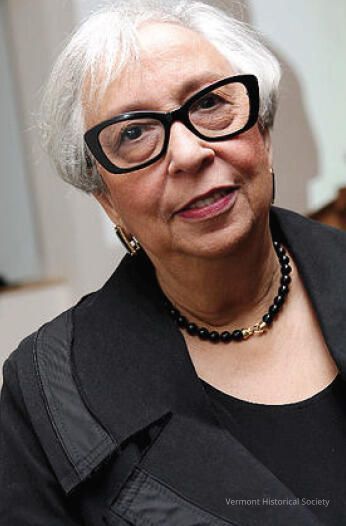
Sandoval, Dolores Sylvia (1937-2015)
Name/Title
Sandoval, Dolores Sylvia (1937-2015)
Description
Born: September 30, 1937 in Montreal, Canada
Died: December 30, 2015 in Montreal, Canada
UVM professor and administrator and first African-American to run for federal elective office from Vermont.
Died: December 30, 2015 in Montreal, Canada
UVM professor and administrator and first African-American to run for federal elective office from Vermont.
Biographical Information
Education
BS, University of Michigan (1960)
MA and PhD, Indiana University (1970)
Biography
Dolores Sandoval was born in Montreal, Canada, on September 30, 1937 but moved to Gary, Indiana, at age seven. She attended college at Indiana University’s Gary Campus, the School of the Art Institute of Chicago, and the University of Michigan, where she received a B.S. from the School of Architecture and Design in 1960. After graduating, she worked for a national personnel firm in New York City and Los Angeles and as an elementary teacher in Gary, Indiana. In 1966, she returned to Indiana University to continue her education, receiving a masters degree and a PhD in Education by 1970.
Dr. Sandoval taught briefly as a reading and language arts consultant at SUNY Buffalo before joining the faculty of the University of Vermont in 1971. Her teaching at UVM specialized in Third World Studies, African Studies and Arts in Education. In 1972, she was appointed Assistant to the President for Human Resources at UVM. She was also a member of both the Governor’s Commission on the Status of Women in 1972 and the Governor’s Task on Women in 1974. Additionally, she served on various other regional committees and boards and worked as a consultant on topics related to education and civil rights.
In 1988 and 1990, Dr. Sandoval ran for the U.S. House of Representatives from Vermont. Sandoval was thought to have been the first African-American to seek federal elective office from Vermont. In 1988, she ran in a four-way primary for the Democratic nomination in which she finished fourth. Paul Poirier won the primary but lost in the general election to Peter Smith. In 1990, she won a three-way race for the Democratic primary. Her opponents in the primary included Peter Diamondstone, who ran again in the general election for the Liberty Union, and write-in candidate, Bernie Sanders, who eventually won the general election as an Independent. Sandoval received 3% of the vote compared with 56% of the vote for Sanders.
She retired from UVM in 1999 and moved to Montreal where she taught at McGill University and established the DaCosta-Angelique Institute for societal change and worked towards creating an immigrant museum.
Occupation
Professor
College Administrator
Entry/Object ID
1.2.13
Web Links and URLs
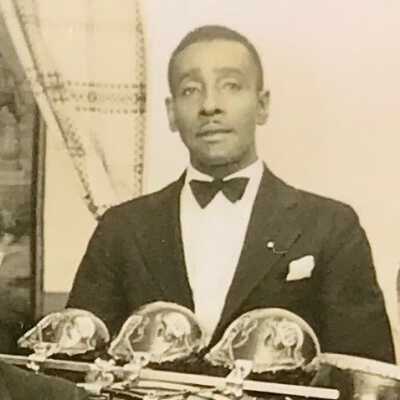
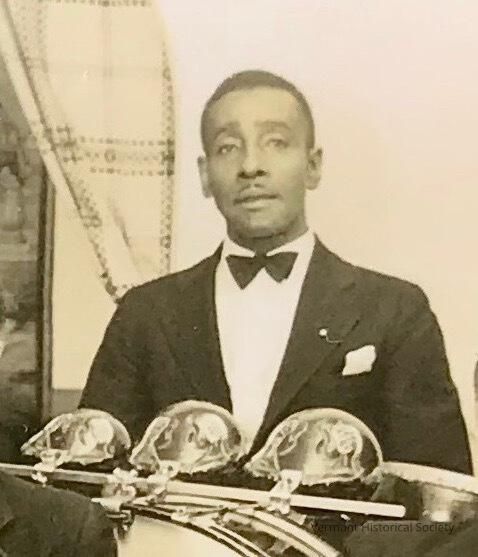
Satchell, Leroy Elmer (1888-1962)
Name/Title
Satchell, Leroy Elmer (1888-1962)
Also Known As
Roy Satchell
Description
Born: Feb. 3, 1888 in Elizabethtown, New York
Died: Jul. 9, 1962 in St. Albans, Vermont
Local musician in St. Albans, Vermont, who played with Sterling Weed's Imperial Orchestra in the 1920s and 1930s making that group the first integrated dance band in New England.
Died: Jul. 9, 1962 in St. Albans, Vermont
Local musician in St. Albans, Vermont, who played with Sterling Weed's Imperial Orchestra in the 1920s and 1930s making that group the first integrated dance band in New England.
Biographical Information
Biography
Leroy Satchell was born in Elizabethtown, New York, to William Satchell and Sophronia Davis. William formerly enslaved in North Carolina and joined the Union Army in 1864 serving as a cook until the war's end. He and his wife moved north to New York, later moving their young family to St. Albans, Vermont.
Leroy lived amongst a thriving Black community in St. Albans where he tried his hand at many jobs throughout his life. He was a laborer and a boot black; he operated a car wash station and served as a chauffeur. His prowess as a boxer and the leading hitter for the local baseball team was noted regularly in the papers. Despite his athletic success, Leroy's true passion and calling was as a musician.
Leroy was a gifted drummer and percussionist. He performed with the St. Albans Brigade Band and played timpani for the St. Albans Symphony Orchestra. He played regularly at dances, glee club events, winter pageants and ceremonies. He made his living at the time by accompanying silent films with a small orchestra at two of St. Albans silent movie theaters, the Bellevue and Empire Theatre. It was here that he met Ora, Lorenzo, and Sterling Weed, the leaders of Weeds Imperial Orchestra, a jazz band of some note.
As a member of Weeds Imperial Orchestra, he traveled around Northern New England, Southern Quebec, and up and down the East Coast playing music for thousands at local dances and events. As with many musicians, he supplemented his evening work by giving drum lessons during the day to young up-and-coming percussionists. After an automobile accident in 1930 left him unable to play or travel for a number of months, he brought in a young protege named Robert Williams to substitute for him so that Weeds Imperial Orchestra could fulfill it's performance schedule. Robert Williams, a young Black man with whose family Leroy had boarded in his younger days, was a student of Leroy's. Eventually the two men would trade dates with the group back and forth until the band stopped playing in the 1950s with the onset and popularity of "cowboy music".
In his later years, Sterling Weed recalled Leroy as an "artist on the drums whose playing was distinctive and very musical." Leroy died on July 9th, 1962, but his student, Robert Williams, went on to play with Weeds Imperial Orchestra after it regrouped in the 1970s and 1980s.
Entry/Object ID
1.2.30
Web Links and URLs
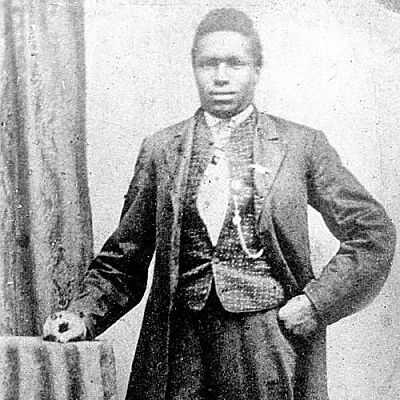

Turner, Alec (1845-1923)
Name/Title
Turner, Alec (1845-1923)
Description
Born: 1845 in Port Royal, Virginia
Died: December 30, 1923 in Grafton, Vermont
Primary Residence: Grafton
Alec Turner escaped slavery in 1862 and joined the Union Army in the Civil War. He married and moved to Grafton, Vermont where he built his farm, Journey's end. He and his wife Sally raised thirteen children in Vermont. His daughter Daisy became famous through her interviews with Vermont folklorists.
Died: December 30, 1923 in Grafton, Vermont
Primary Residence: Grafton
Alec Turner escaped slavery in 1862 and joined the Union Army in the Civil War. He married and moved to Grafton, Vermont where he built his farm, Journey's end. He and his wife Sally raised thirteen children in Vermont. His daughter Daisy became famous through her interviews with Vermont folklorists.
Biographical Information
Biography
Alec Turner was born into slavery in 1845 on the Gouldin Plantation in Port Royal, Virginia. The son of an African native and Cherokee Indian, he learned to read at an early age. In 1862 he escaped slavery, making his way to the Union Army lines and joined the First New Jersey Cavalry as an assistant cook. He fought in the battle of Bull Run and was injured in the hip. After recovering he served as a surgeon's assistant. In the spring of 1863 he guided his regiment to his former plantation and allegedly killed the overseer.
Turner married Sally (or Sarah) Early, the daughter of Confederate General Jubal Early and one of his enslaved women. After the Civil War, the Turners first moved to Williamsburg, Maine, where Alec worked in the Merrill Quarry. They eventually left for Boston where they met sawyers Vestus Wilbur and Charles White of Grafton, Vermont who hired Alec to work for them.
The Turner's arrived in Grafton in the fall of 1872 and settled on Bare Hill. Working as a sawyer and a logger, Alec earned enough money to eventually purchase 150 acres of land that became Journey's End Farm. This place was the end of his long journey from slavery. Alec and Sally raised thirteen living children in Grafton. Sally's brother and family eventually joined them in Vermont. Alec received a full pension from the U.S. government for his service in the Civil War and was an active member of the G.A.R.
Alec and Sally's daughter Jessie, known as Daisy, lived to the age of 104 and recounted Alec's life story as well as her own experiences growing up black in Vermont to folklorist Jane Beck in the 1980s. The cabin at Journey's End (the house burned in 1962) is in the process of being preserved and is the first stop on Vermont African American Heritage Trail.
Occupation
Sawyer
Logger
Farmer
Entry/Object ID
1.2.19
Web Links and URLs
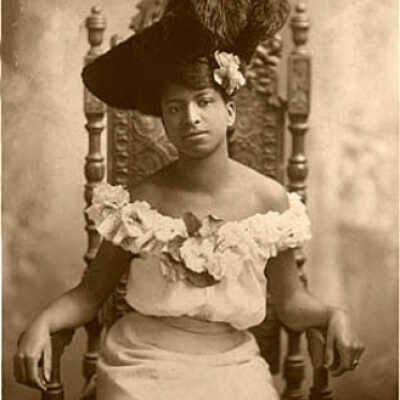
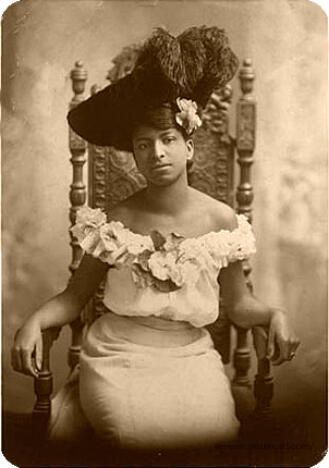
Turner, Daisy (1883-1988)
Name/Title
Turner, Daisy (1883-1988)
Description
Born: June 21, 1883 in Grafton, Vermont
Died: February 8, 1988 in Springfield, Vermont
Primary Residence: Grafton
Daughter of former slaves who moved to Vermont after the Civil War. Gifted storyteller and rights activist. She lived for over a century and is the subject of several works by the Vermont Folklife Center.
Died: February 8, 1988 in Springfield, Vermont
Primary Residence: Grafton
Daughter of former slaves who moved to Vermont after the Civil War. Gifted storyteller and rights activist. She lived for over a century and is the subject of several works by the Vermont Folklife Center.
Biographical Information
Biography
Daisy Turner was born in Grafton, Vermont, one of thirteen children born to parents who were former slaves. She was a famous for her oral recordings of her family's history, which can be traced back three generations to Africa.
Turner's great-grandmother was shipwrecked while traveling from England to Africa on her honeymoon during the early 19th century. She was saved by an African chieftain's son, and had a child with him (Daisy's grandfather, Alexander). Alexander was captured by a slave trader and taken to New Orleans, where he was bought by John Gouldin and taken to Gouldin's plantation in Port Royal, Virginia. There, Daisy's father, Alec, was born a slave. Alec was taught to read by the master's granddaughter, and later escaped, joining the Union Army during the Civil War. After the Civil War, the Turner family moved north, where her father worked in a saw mill and raised enough money to purchase a 100 acres in Grafton, Vermont and build Journey's End Farm.
Daisy Turner was proud of her family heritage, and was a strong, outspoken woman from childhood to her death at the age of 104.
Daisy Turner is remembered as a gifted storyteller and family historian. She is the subject of the Vermont Folklife Center's Peabody Award-winning audio documentary, "Journey's End: The Memories and Traditions of Daisy Turner". Stories from her life have also been the subject of two Vermont Folklife Center books, "Alec's Primer" and "Daisy and the Doll".
Daisy Turner maintained Journey's End after her parents' deaths. The Turner family homestead is located on the "Daisy Turner Loop", a biking trail near Grafton Pond.
Occupation
Storyteller
Farmer
Entry/Object ID
1.1.91
Web Links and URLs

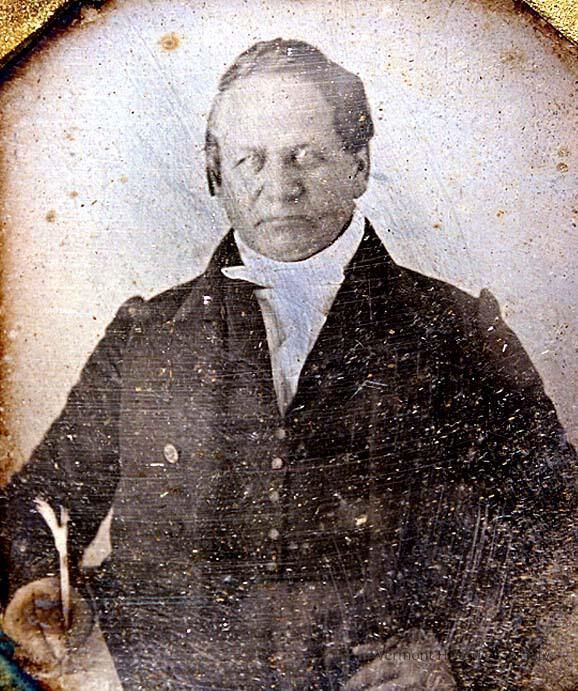
Twilight, Alexander Lucius (1795-1857)
Name/Title
Twilight, Alexander Lucius (1795-1857)
Description
Born: September 23, 1795 in Corinth, Vermont
Died: June 19, 1857 in Brownington, Vermont
Alexander Twilight is the first African-American known to have earned a bachelor's degree from an American college or university, graduating from Middlebury College in 1823. He was licensed as an Congregational preacher (not ordained). He was principal of the Orleans County Grammar School where he designed and built Athenian Hall, the first granite public building in the state of Vermont. In 1836 he was the first African-American elected as a state legislator, serving in the Vermont House of Representatives. He was also the only African-American ever elected to a state legislature before the Civil War.
Died: June 19, 1857 in Brownington, Vermont
Alexander Twilight is the first African-American known to have earned a bachelor's degree from an American college or university, graduating from Middlebury College in 1823. He was licensed as an Congregational preacher (not ordained). He was principal of the Orleans County Grammar School where he designed and built Athenian Hall, the first granite public building in the state of Vermont. In 1836 he was the first African-American elected as a state legislator, serving in the Vermont House of Representatives. He was also the only African-American ever elected to a state legislature before the Civil War.
Biographical Information
Education
Orange Country Grammar School
BA, Middlebury College (1823)
Biography
Alexander Twilight was born to a white or "fair-skinned" mother and a biracial, Revolutionary War Veteran father on their farm in Bradford, Vermont. Due to poverty, Twilight was forced to work as an indentured servant on a farm in neighboring Corinth from the age of eight to end of the indenture at age 21. During this time he attended school, ultimately finishing two years of college-level curriculum at the Orange County Grammar School in Randolph, Vermont.
He enrolled in Middlebury College in 1821 and graduated with a bachelor's degree in 1823, the first African-American to receive a degree from any U.S. college or University. He embarked on a career of teaching in Peru, New York. While there he started studying for the ministry, and though not ordained, he received a license to preach from the Congregational Church.
He went on to teach and preach in Vergennes, Vermont, and ultimately settled in Brownington in 1829 where he was named the principal of the Orleans County Grammar School and minister of the Congregational Church.
As the only secondary school in the region, Twilight saw a need for a dormitory so students could stay at the school to study. From 1834 to 1836 he designed and built Athenian Hall (now the Old Stone House Museum) as dormitory and school building for the newly-named Brownington Academy. This lofty structure was the first granite public building in the state of Vermont.
Alexander Twilight was elected to the Vermont House of Representatives in 1836, becoming the first African-American to win election to a state legislature in the United States and the only black man to serve in this capacity until after the Civil War.
Twilight served Brownington until 1847 when an apparent falling-out with the school board of trustees forced his resignation. He taught in nearby Quebec, but without his leadership Brownington Academy ended up closing in 1852. The school asked him to come back which he did, returning as principal and pastor until a stroke forced his retirement in 1855. He died two years later and is buried at the Congregational Church in Brownington.
Occupation
Teacher
Minister
Entry/Object ID
1.2.4
Web Links and URLs
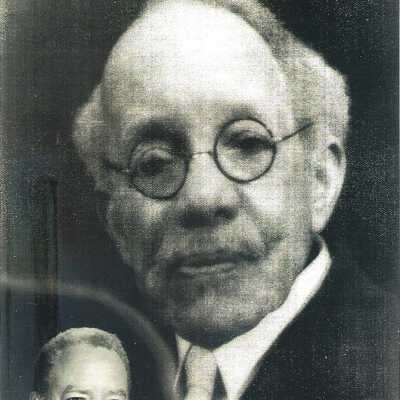
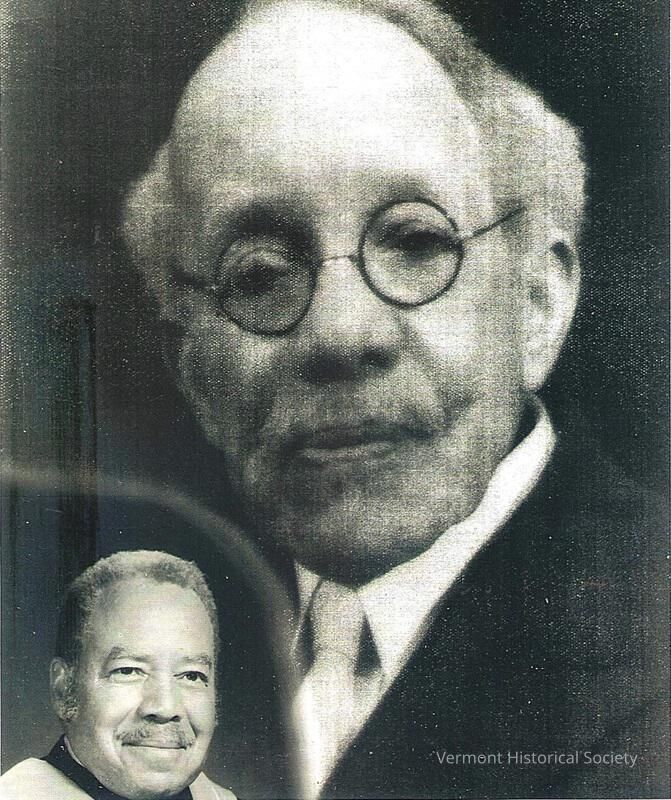
Williams, Samuel (1852-1946)
Name/Title
Williams, Samuel (1852-1946)
Also Known As
Aleckson, Sam
Description
Born: 1852 in Charleston, South Carolina
Died: April 10, 1946 in Cambridge, Massachusetts
Under the pen name Sam Aleckson, Samuel Williams wrote his memoir "Before the War and After the Union" while living in Vermont. Born into slavery in South Carolina, Williams bears witness to slavery, reconstruction, and life as a black man in the north.
Died: April 10, 1946 in Cambridge, Massachusetts
Under the pen name Sam Aleckson, Samuel Williams wrote his memoir "Before the War and After the Union" while living in Vermont. Born into slavery in South Carolina, Williams bears witness to slavery, reconstruction, and life as a black man in the north.
Biographical Information
Biography
Born into slavery in 1852 in Charleston, South Carolina, Samuel Williams spent his early years separated from members of his family serving various white households. While enslaved he learned to read and write, a fairly uncommon occurrence in the south. He witnessed the great Charleston fire of 1861 that financially ruined the family that enslaved him. He experienced the Civil War as an enslaved servant of a Confederate Officer, stating in his memoir that "I must admit, I wore the 'grey'."
Williams was freed when Union Troops, many members of the 21st Regiment U.S. Colored Infantry, entered Charleston on February 18, 1865. He writes of joining a large crowd of freed slaves to watch the U. S. flag raised over Fort Sumter.
After the war, his family reunited and lived in Charleston during reconstruction. He writes extensively of living under restrictive Black Codes, laws that restricted the movement, employment, education, and residences of black citizens.
In 1890, Williams and his second wife, Henrietta, moved from Charleston to Springfield, Vermont, where he was employed as a domestic servant and laborer. In 1910, fearing he would go blind, he penned his memoir under the name Sam Aleckson. Though he used real names and places in reflecting on his life in the south, he created fictitious names and places for life in the north.
That same year, his wife died and he moved to his daughter's home in Lebanon, New Hampshire. In 1929 he finished his memoir and self-published the manuscript through his son-in-law's press.
Occupation
Laborer
Writer
Entry/Object ID
1.2.25
Web Links and URLs